Report

Asia-Pacific private equity (PE) investors were braced for a tough 2020. Two years of record investment in the region ended in 2019 with a sharp decline in deal value, exits, and fund-raising. Then Covid-19 struck. Stunned by the fallout, investors recoiled at first. But many quickly jumped back into the market, especially in China, India, and Japan, lifting deal value across the region to a record high.
China was the first country to lock down and the first to recover. As soon as the pandemic started to ease, the country’s general partners (GPs) quickly got back to work closing deals that they had put on hold. In India, a series of private equity deals in the second quarter totaling almost $10 billion in technology multinational Jio Platforms helped inject energy back into the market.
Robust dealmaking helped Asia-Pacific assets under management rise to 28% of the global PE market. Returns remained strong, and private equity again outperformed the region’s public markets by at least 3 percentage points across 5-, 10-, and 20-year horizons.
Apart from a record level of investment and steady returns, though, it was a tough year. Covid-19 lockdowns torpedoed economic growth across the region, ending a decade of relative stability. Many industries suffered as workplace foot traffic all but disappeared, hurting retailers that were unprepared or unable to shift their businesses online.
Recession and market turbulence took a toll on the private equity market, curtailing exits and fund-raising. Secondary and trade exits became more difficult to do, leaving the number of exits near a 10-year low. On a positive note, the revival of stock markets in the second quarter enabled the initial public offering exit channel to thrive. Without it, exit value would have been even more depressed.
Record levels of dry powder increased competition for good deals
Fund-raising activities declined for the third consecutive year, as Asia-Pacific funds again distributed less capital to LPs, slowing the virtuous industry life cycle. Efforts to launch new funds were hampered by unfavorable market conditions, travel restrictions, and increased caution among limited partners (LPs). However, most GPs suffered no shortage of dry powder. The industry’s store of unspent capital climbed to a new high, reducing pressure on GPs to raise new funds.
GPs biggest concern is high valuations, according to Bain’s 2021 Asia-Pacific private equity survey, conducted with 162 senior market practitioners. Following a dip in 2019, valuations rose slightly year-on-year, buoyed by vibrant stock markets, increasing competition and adding to record levels of dry powder.
Successful GPs weathered the storm of 2020 in part by focusing on digital business sectors poised to outperform.
Looking forward, there’s light on the horizon. Though GPs are concerned about the ongoing effects of Covid-19, nearly 80% expect the macroeconomic climate to be more favorable this year, given the approval of promising vaccines last December. Deal value is likely to continue at a healthy clip as the dearth of exits in 2020 and mounting stores of unspent capital increase pressure on GPs to trim portfolios and find new investments. And several large deals that were delayed in 2020 are likely to close this year. Vigorous dealmaking, however, may nudge valuations higher.
Successful GPs weathered the storm of 2020 in part by focusing on digital business sectors poised to outperform. But even when the pandemic starts to ease, many challenges will remain, including geopolitical tensions, the US–China trade dispute, climate change, and other uncertainties. Anticipating tougher export conditions or even supply chain disruptions, many GPs are stepping up efforts to develop domestic markets and domestic demand. At the same time, leaders are taking new steps to build resilience into their portfolio companies to mitigate the risks of future disruptions.
What happened in 2020?
It was a startling year of contrasts for Asia-Pacific’s private equity market. Covid-19 lockdowns precipitated a plunge in first-quarter activity, but investors returned to the market with pent-up energy in the second quarter. Dealmaking reached a climax in the fourth quarter, powering the region to record deal value. The surge was even more surprising, given the steady drumbeat of worrying economic news. Asia-Pacific GDP growth fell sharply after years of relative stability, and unemployment in most countries soared to 10-year highs.
Importantly, dealmaking in Greater China, the region’s powerhouse market, rebounded sharply from a 35% drop in 2019. Deal value growth in other markets was mixed. Private equity remained a popular source of capital in the region, representing 19% of the Asia-Pacific mergers-and-acquisitions market, up from the previous five-year average of 17%.
Deals: A remarkable rebound
Across the region, GPs and LPs braved tough investment conditions and were surprisingly active throughout the year—though the vast majority of transactions were virtual. Asia-Pacific deal value rose to a record $185 billion, up 19% over 2019 and 23% over the previous five-year average (see Figure 1).
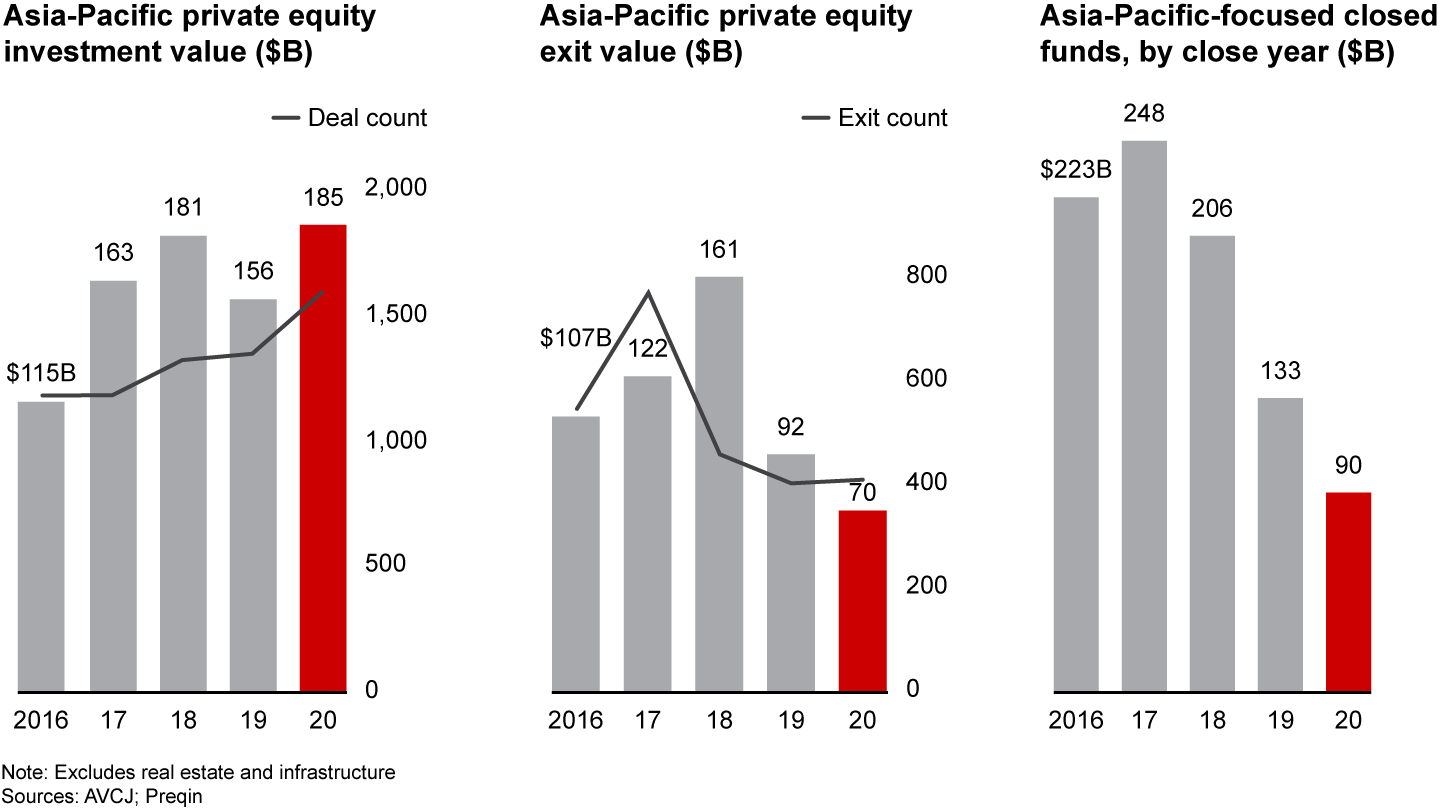
Greater China again led dealmaking activity in the region, contributing more than 2.5 times the deal value of India, which ranked second in deal value (see Figure 2). In 2020, China was the only country in the region to avoid a drop in GDP. China’s total deal value rose to $97 billion, up 42% from 2019 and 22% higher than the previous five-year average. Government-guidance or -affiliated funds, which are government-backed, continued to play a significant role facilitating domestic deals.
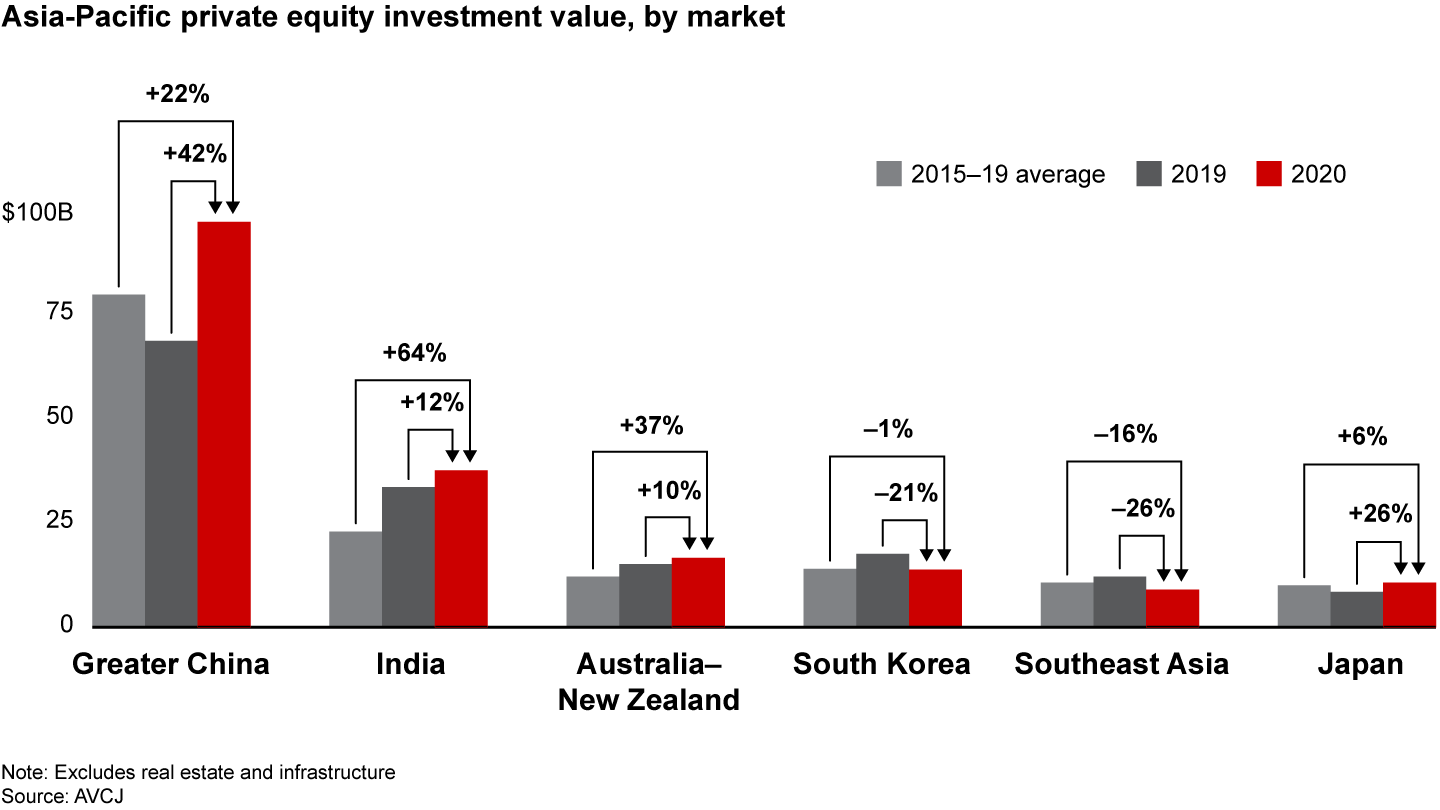
Asia-Pacific investors targeted fast-growing companies with digital business models and platforms that were boosted by the switch to virtual work, education, and retailing. These digitally accelerated sectors include e-commerce, e-learning, digital healthcare, online booking services, online entertainment, and digital payments and financial services.
India continued to increase its share of deal activity in the region. Deal value rose to $38 billion, up 64% over the prior five-year period. The growth came partly from an extraordinary series of 10 private equity investments totaling almost $10 billion in technology multinational Jio Platforms, and seven investments in Reliance Retail. Both Jio and Reliance Retail are wholly owned subsidiaries of Reliance Industries Limited, which is building an array of technology companies in such fields as mobile services, cloud computing, Internet, e-commerce, and artificial intelligence. GPs see significant opportunity in India’s fast-growing Internet and technology sector, which is powered in turn by an expanding middle class, government incentives, and a maturing cohort of Indian technology companies.
While deal value grew in Japan and Australia–New Zealand from the previous five-year averages, South Korea’s deal activity was on par with previous years. Travel restrictions affected deal activity significantly in Southeast Asia, where deal value declined 16% over the previous five-year average.
Average deal size varied by type
- $317 M Average deal value for buyouts
- $97 M Average deal value for growth deals
Asia-Pacific PE investors completed a few high-profile megadeals valued at more than $1 billion, including the $8.7 billion acquisition of 58.com, an online classifieds platform in China. Megadeals increased in Australia, compared with the previous five-year period. But in an unusual twist, Southeast Asia was home to only one megadeal: infrastructure company Equis Development for $1.3 billion. And South Korea had none.
In 2020, the region generated no deals over $10 billion, such as the sales of Toshiba Memory ($15 billion) in 2017 and Ant Financial ($14 billion) in 2018, which boosted deal value to record levels in those years. The region’s average deal size in 2020 was $117 million, slightly lower than the previous five-year average of $120 million.
However, the average deal size varied substantially by deal type. The average deal value for buyouts was $317 million, roughly at par with the previous five-year average. Growth deals averaged $97 million, down 10% from the prior five-year average (see Figure 3).

While growth deals made up 60% of Asia-Pacific deal value, the dominant deal type varied substantially by market. In India and Southeast Asia, for example, growth deals made up more than 80% of the total deal value. By contrast, in South Korea, Japan, and Australia–New Zealand, the majority of deals were buyouts (see Figure 4).
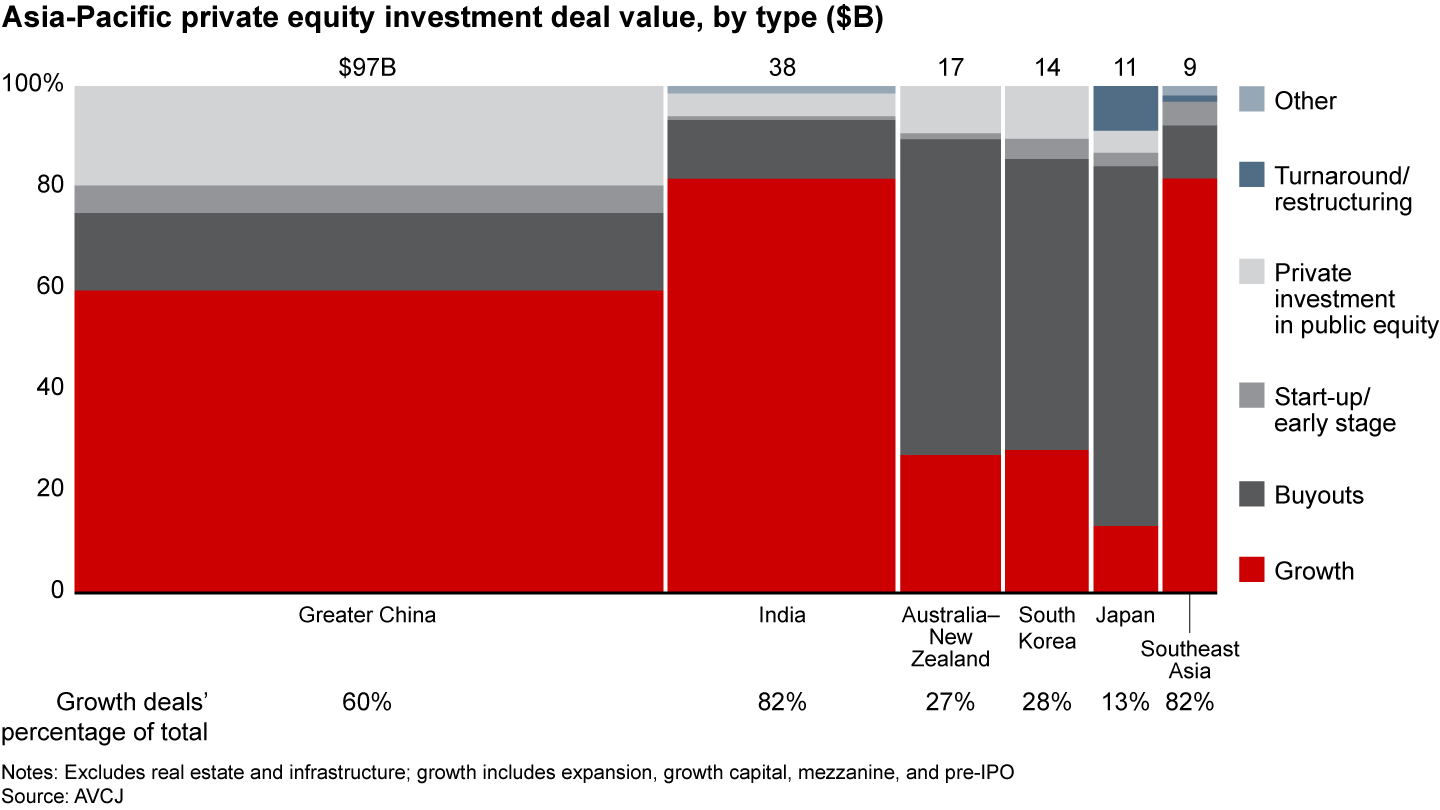
Secondary and public-to-private deal value shrank in 2020 from previous years. However, carve-out deals more than doubled in value from 2019, buoyed by large investments such as Japan’s Takeda Consumer Healthcare Company ($2.3 billion) and the Reliance Retail deals.
Building on a multiyear trend, GPs continued to concentrate their investments in a few key sectors. Healthcare and Internet–technology deals again made up more than 50% of Asia-Pacific deal activity by value (see Figure 5). Internet–technology was the largest sector for the ninth year running, with $77 billion in deal value, increasing 12% over the previous five-year average and representing 42% of deal activity. More than 60% of GPs said they’re seeking to identify the most attractive subsectors based on changing consumer behaviors.
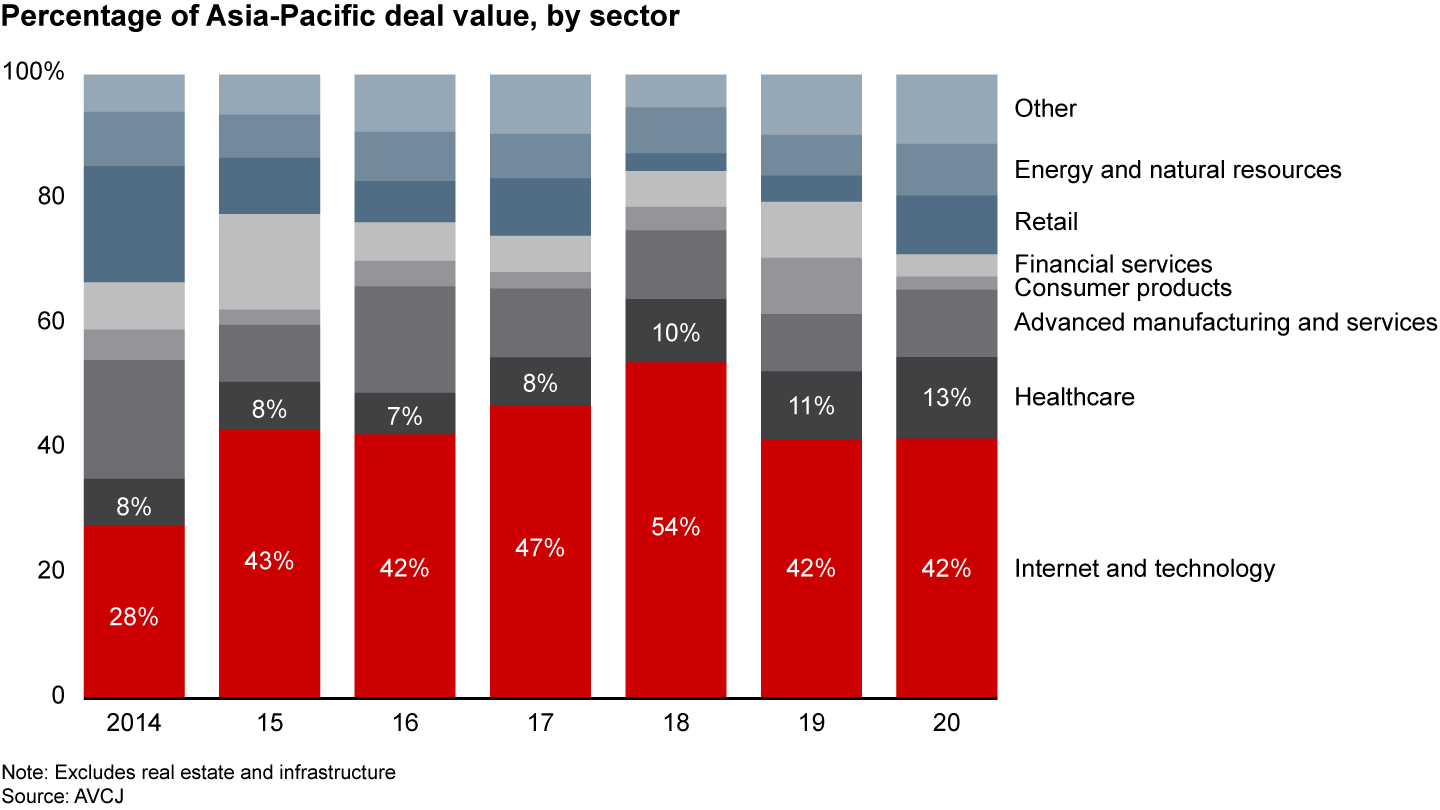
In response to challenging market conditions, funds increasingly teamed up—a trend called “deal clubbing”—to make the most of their complementary expertise and resources, and to lower risk. The number of investors per deal increased to a record 3.4, buoyed by growth deals, which averaged 3.9, up 25% from the prior five-year average. LPs are also seeking larger investment opportunities and offering more coinvestments to GPs. Corporate investors remained prominent as well.
Deal multiples—the ratio of enterprise value to EBIDTA—recovered slightly to 11.7, after dipping to 11.1 in 2019 (see Figure 6). The all-time high for deal multiples was 14.5 in 2018. Public markets bounced back quickly following the initial shock of Covid-19, helping support valuations. At the same time, record levels of dry powder increased competition for good deals. GPs felt the effects quickly: Forty percent say valuations increased in 2020, and 63% say higher multiples is one of their top concerns. A strong majority, nearly three-quarters, expect prices to stay the same or increase in the next two years.
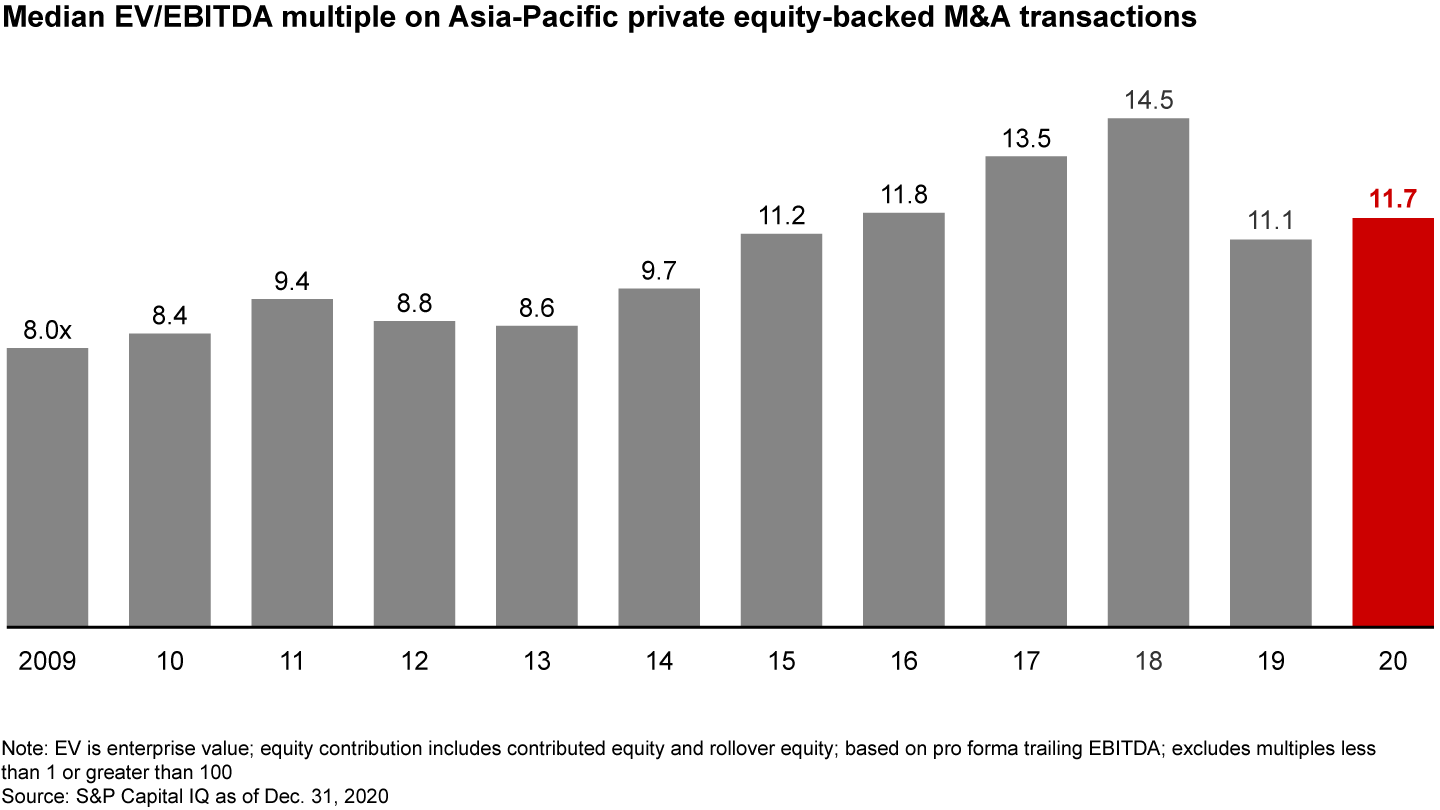
Despite the Covid-19 lockdowns and ongoing economic uncertainty, the number of active investors in the region continued to climb, rising 16% in 2020 to 2,212. That compared with a 13% average annual rise during the previous five years. The increase partly reflects a growing number of LPs and corporate investors making direct investments. However, deal value remains relatively concentrated, with the top 20 funds involved in almost one-third of deals by value, roughly the same as previous years.
Asia-Pacific GPs view global PE firms and local or regional firms as their biggest competitive threats—and with good reason. Global GPs, with their access to larger pools of expertise and worldwide networks, and domestic GPs, with their deep local expertise, were by far the most active investors in the region, expanding their share of deal involvement over previous years to 34% and 26%, respectively (see Figure 7).
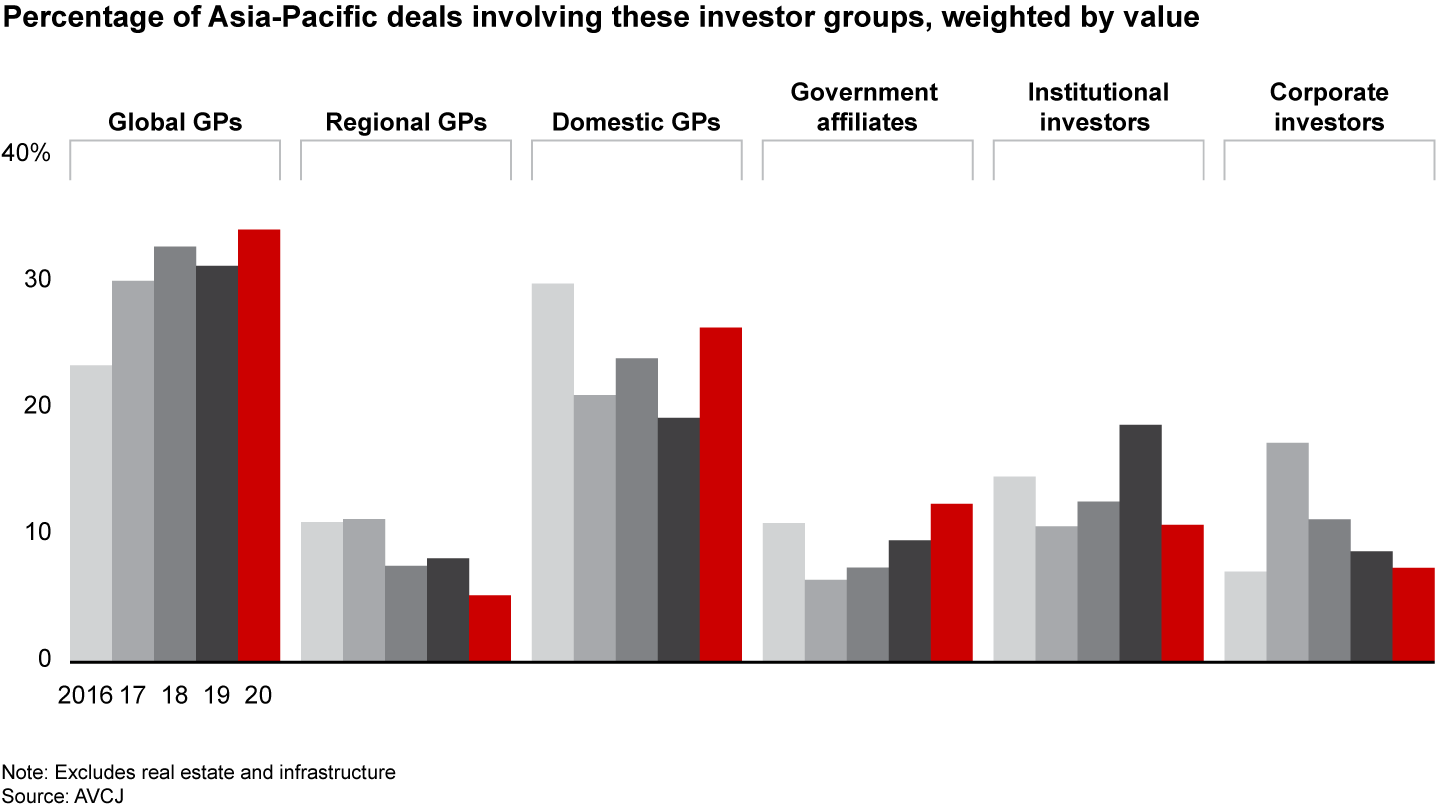
In China, domestic GPs were more active than global investors, who remained cautious in the face of Covid-19 and geopolitical tensions. In India, however, global GPs were involved in half of all deals by value, attracted in part by increased confidence in the Indian market and the series of deals in Jio Platforms and Reliance Retail.
Exits hover near a 10-year low
Following a breathtaking fall to a 10-year low in 2019, the number of exits was flat last year, limiting distributions in the region. Exit deal value totaled $70 billion, down 24% year-on-year and 40% from the previous five-year average, as PE managers waited for better times to sell portfolio companies (see Figure 8).
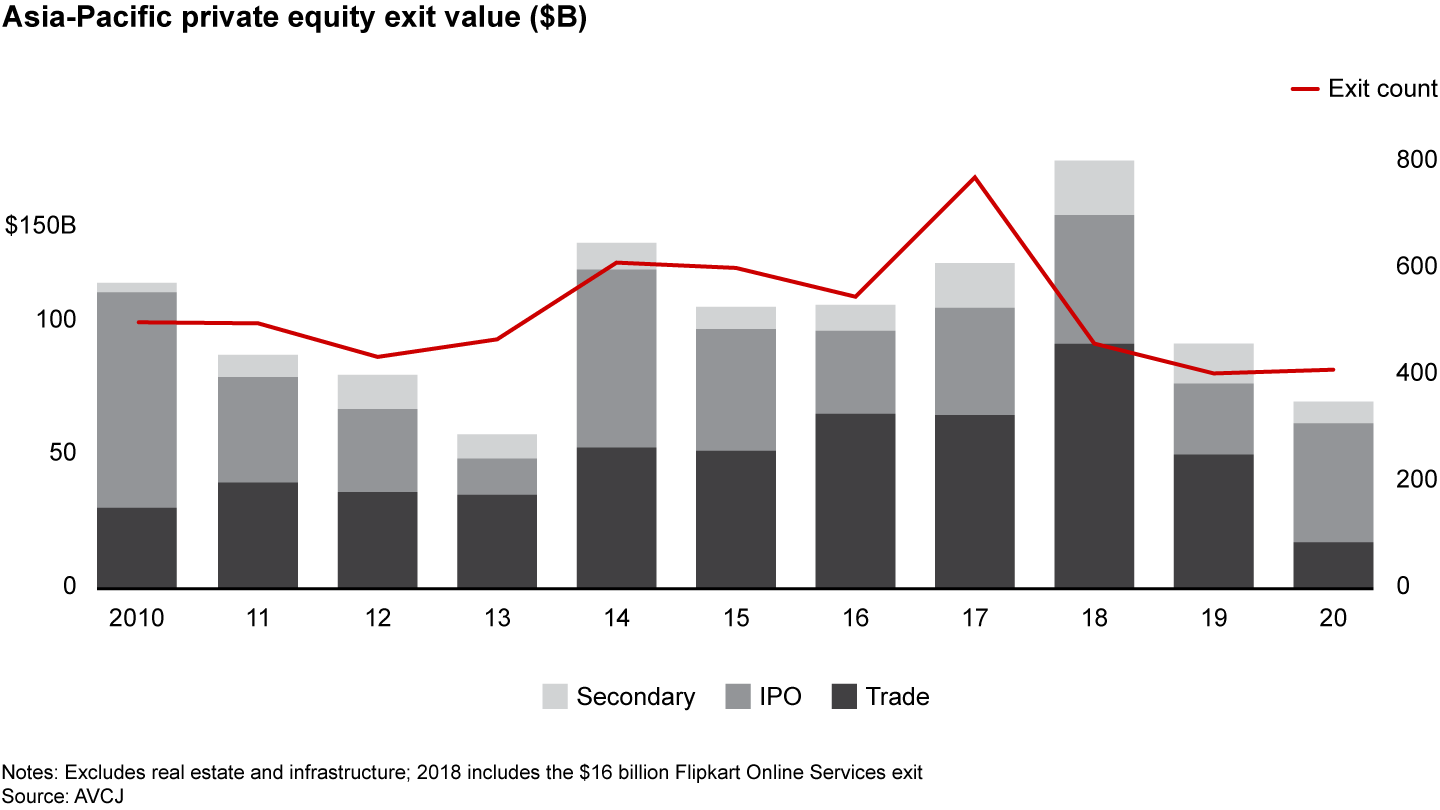
Of the GPs we surveyed, more than 70% say the exit environment was more challenging than in 2019. Those who participated in few or no exits point to Covid-19 as the principal cause for a weak exit environment.
The economic fallout from Covid-19 hit trade sales and secondary exits hardest. Many GPs put planned sales on hold, preferring to wait out market uncertainty. Instead of exits, they pivoted their attention to keeping portfolios in the black.
One bright spot was the initial public offering (IPO) exit channel. IPOs dominated the exit market, making up more than 60% of exits by value, almost double the previous five-year average. Stock markets remained open even during lockdowns, and investment activity recovered quickly after the first quarter, helping PE funds complete sales in the second quarter that had been initiated earlier, but stalled during the peak of the crisis.
China accounted for 86% of the region’s IPOs, fueled in part by a number of foreign issuers completing secondary listings in Hong Kong (see Figure 9). The majority of IPOs in China were healthcare and technology companies. PE funds resorted to IPOs less frequently for portfolio companies in traditional industries.
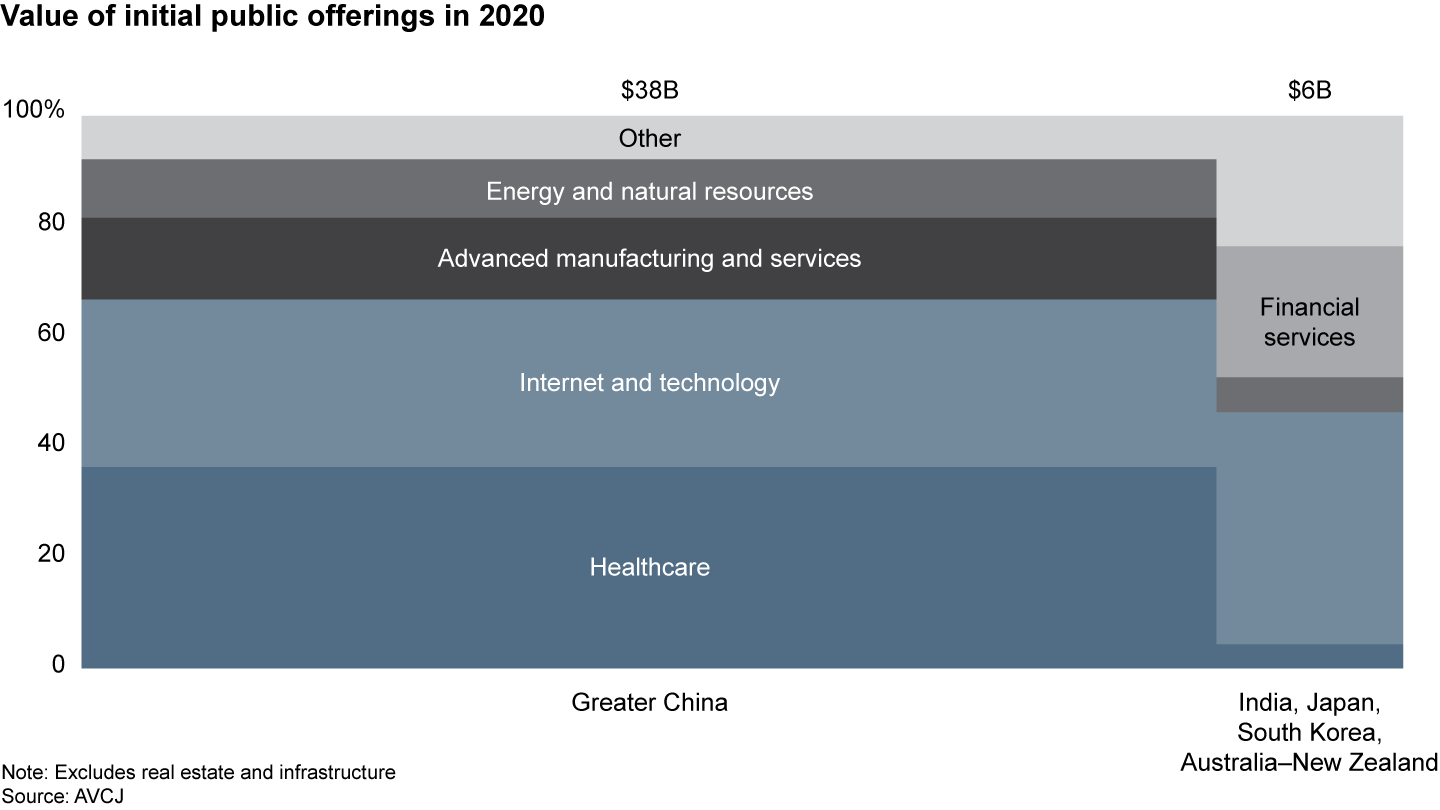
The fall in exit activity affected almost all countries and subregions. Only Greater China and Australia–New Zealand reported an increase in the volume of deals—mostly smaller ones—but exit value was subdued across the board (see Figure 10). In Southeast Asia, Covid-19 took a severe toll. Exit activity, much like deals, slowed dramatically, with only eight exits exceeding $10 million in value. Seven of these took place in the second half of the year. Nearly half of Southeast Asia’s exit value came from one megadeal in Indonesia, CVC Capital Partners’ $1.2 billion sale of Softex Indonesia to Kimberly-Clark. Since public markets in the country are less developed, the IPO channel wasn’t an attractive alternative to trade sales.
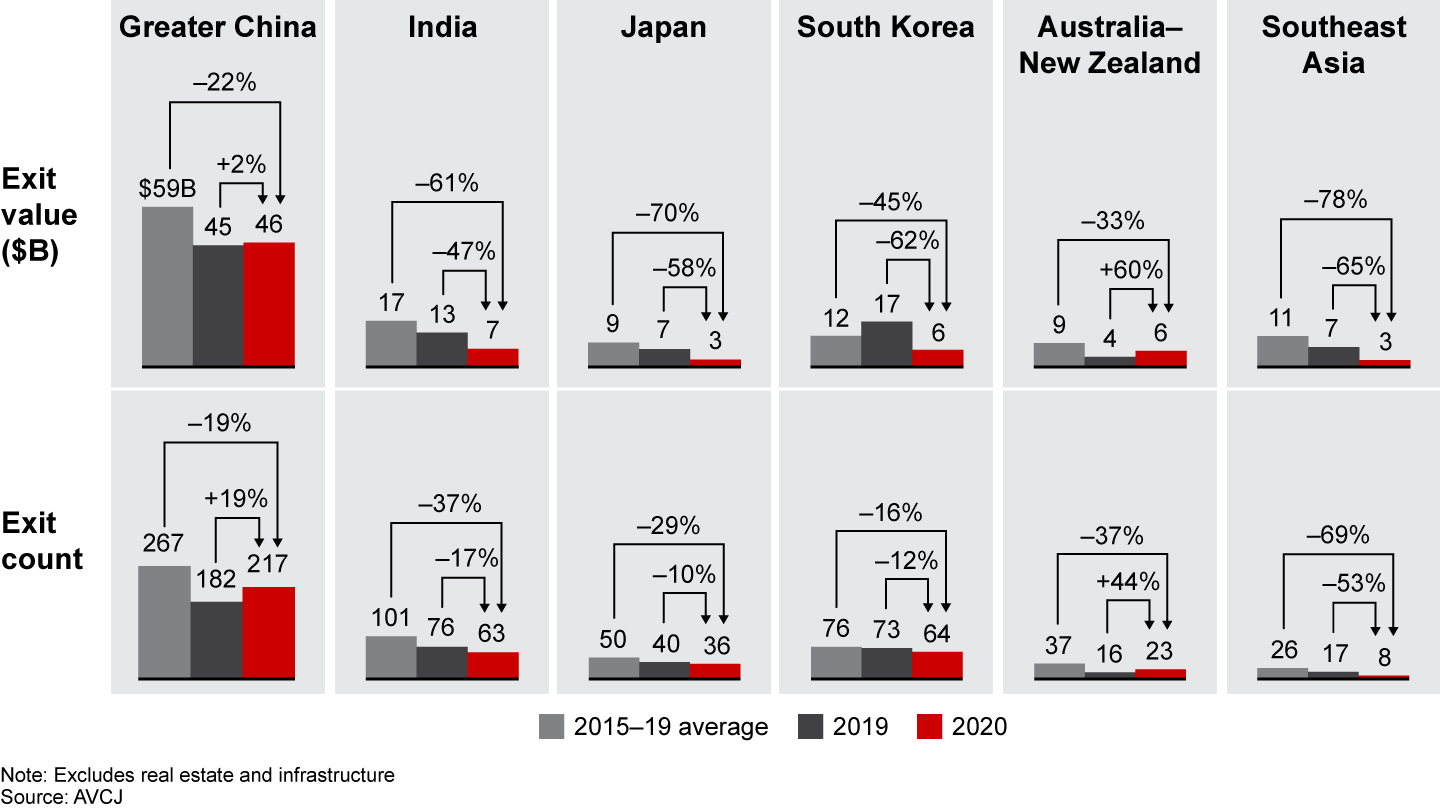
Exit value declined sharply in India, Japan, South Korea, and Southeast Asia, with India’s exit value dropping 47% year-on-year. Shrinking exit values across most of the region helped boost Greater China’s share of Asia-Pacific exit value to more than 65%, up from the previous five-year average of 50%. China’s exit market was more robust than in other countries thanks to an active IPO channel, particularly in Hong Kong. China’s economy also recovered faster from the initial Covid-19 shutdowns than other countries in the region.
As GPs deferred exits, the value of the companies held in PE portfolios, or unrealized value, continued to climb, reaching $1.04 trillion, up 33% year-on-year. The median holding period was 4.5 years, slightly above the five-year average. GPs’ inclination to wait for better exit conditions has created an exit overhang for 2014–2016 portfolios, which will increase pressure on fund managers to accelerate exits in coming years (see Figure 11).

The main factors determining successful exits in 2020 were “very clear and keen buyers at exit” (almost 50% of respondents) and strong market growth (almost 40%), according to GPs. Both were scarce in 2020, except in a few digital sectors such as e-commerce and e-learning, where growth accelerated following the Covid-19 lockdowns.
The primary reason for unsuccessful exits in 2020 was a poor macroeconomic climate, including the effects of Covid-19 on regional economies, according to 60% of GPs. In 2019, GPs ranked IPO market underperformance and unpredictability and macroeconomic softness as the most important factors undercutting deal success.
Fund-raising tumbles again
Fund-raising was a somber affair in 2020, overshadowed by a poor exit environment. Asia-Pacific-focused funds raised $90 billion, down 32% year-on-year, 53% from the prior five-year average, and 64% from the peak year of 2017 (see Figure 12). The number of funds closed fell to 356, down 76% from the 2017 peak. Those that succeeded were either established regional funds with a strong track record or smaller, first-time funds with attractive angles of differentiation and sector expertise.

By contrast, global PE fund-raising (all categories, including buyout, growth, and start-up) declined only 11%. Asia-Pacific’s sharper decline pushed down the share of purely Asia-Pacific-focused funds as a percentage of the global total to 12% (see Figure 13). More than 60% of GPs in the region said the fund-raising environment in 2020 was challenging—but only 32% expect the environment to remain unfavorable in 2021.
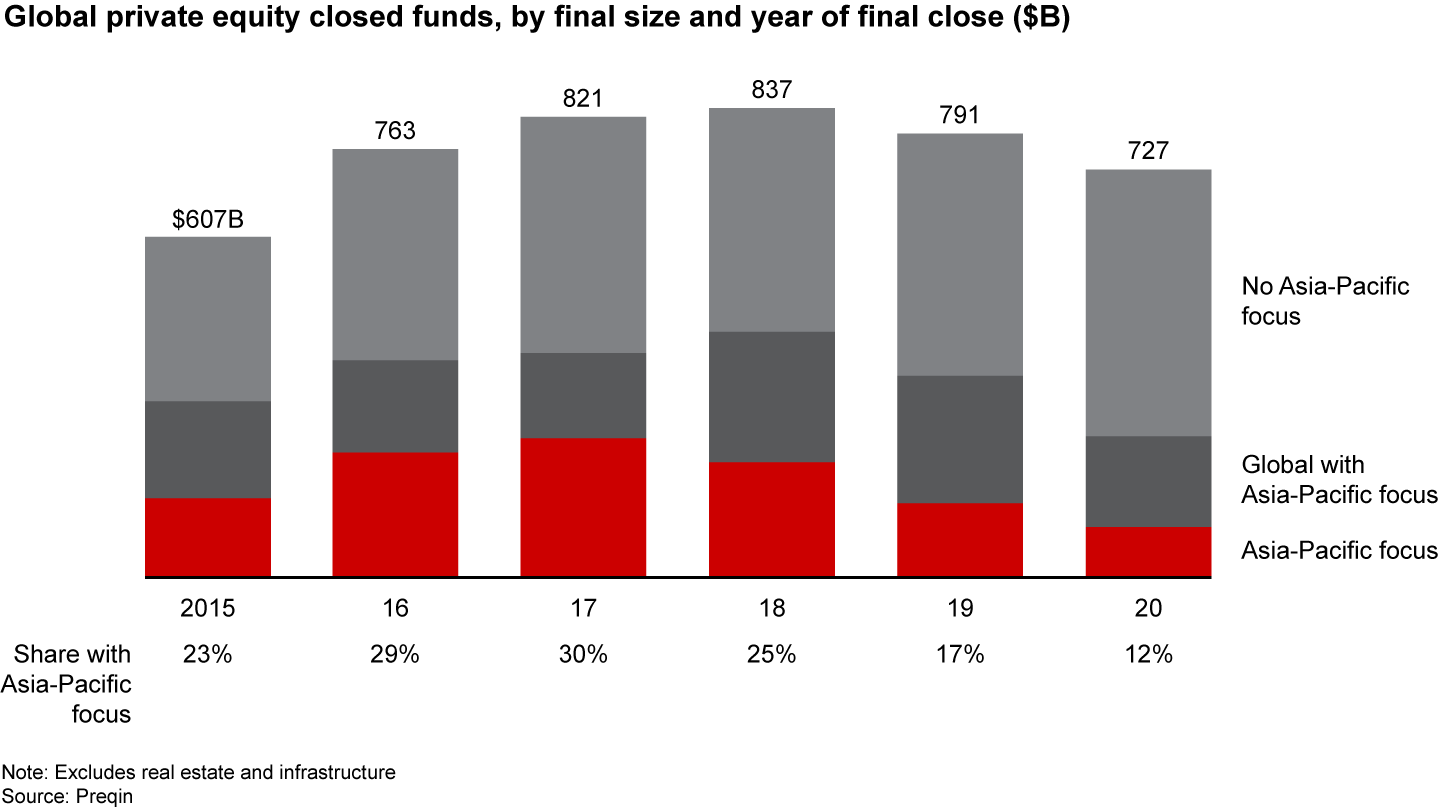
Despite the sharp drop in fund-raising, dry powder reached another new high as market uncertainty and high valuations kept some investors on the sidelines. GPs raised peak sums during the past few years, so most are well-positioned to delay fund-raising until market conditions improve. Total unspent private equity capital at Asia-Pacific-focused funds rose 22% to a record $477 billion, representing 3.2 years of future investment, up from 2.7 years in 2019 (see Figure 14).
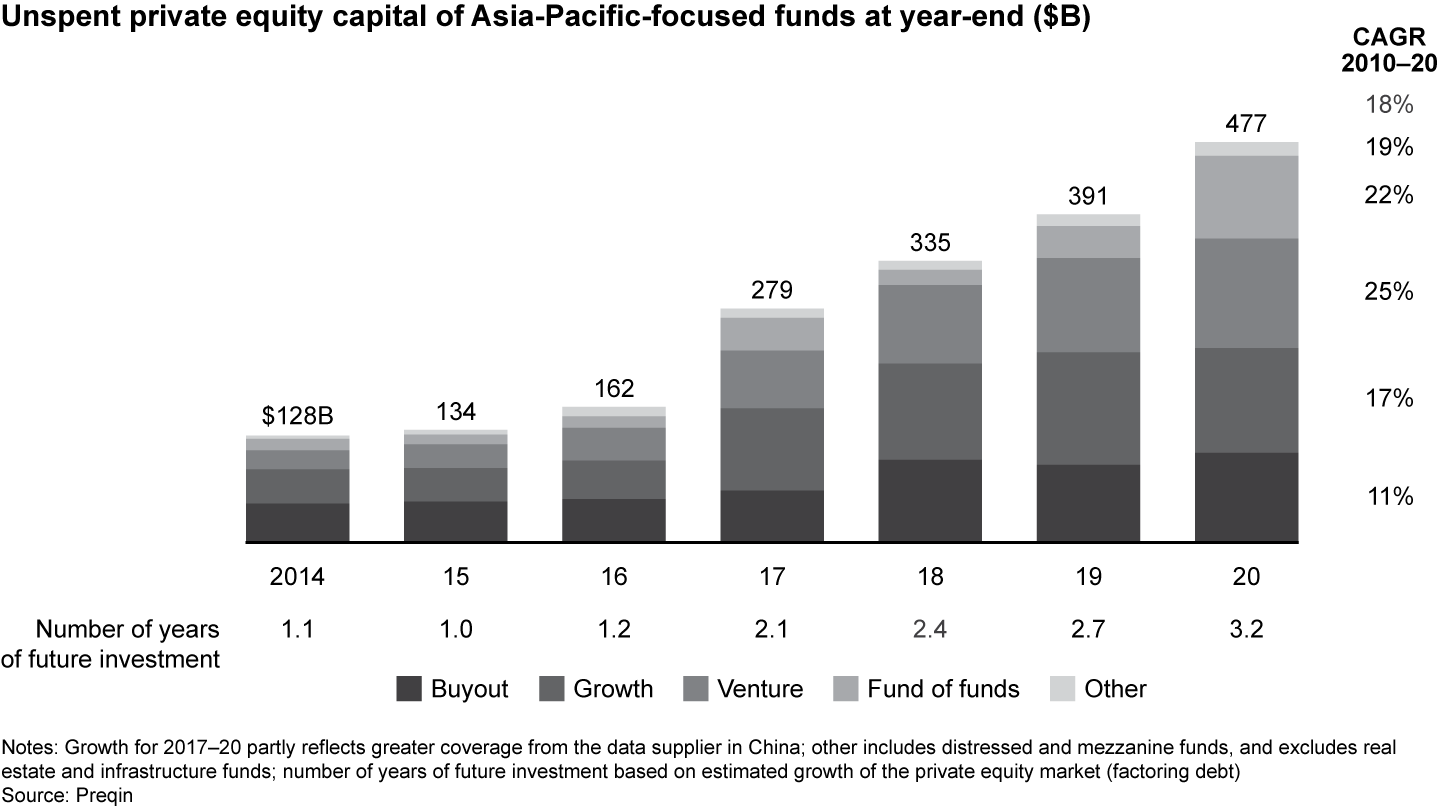
China renmimbi-based funds again raised the most capital throughout the region, although China government-guidance or -affiliated funds raised half the total. Four of the top 10 Asia-Pacific funds raised in 2020 were China government-guidance funds (GGFs). Renminbi-denominated fund-raising for non-GGFs continued to suffer from a lack of liquidity due to asset management regulations that China put in place in 2018.
Pan-Asia-Pacific funds accounted for nearly 30% of total Asia-Pacific-focused capital raised in 2020, a slight increase from previous years. However, the amount of capital raised declined 17% to $25.7 billion, as many Asia-Pacific-focused GPs put fund-raising on hold in 2020. However, GPs who launched funds were well-prepared and secured relatively strong LP support. As a result, the average size of funds closed rose and Asia-Pacific funds largely met their target fund-raising size for the year (Figure 15).
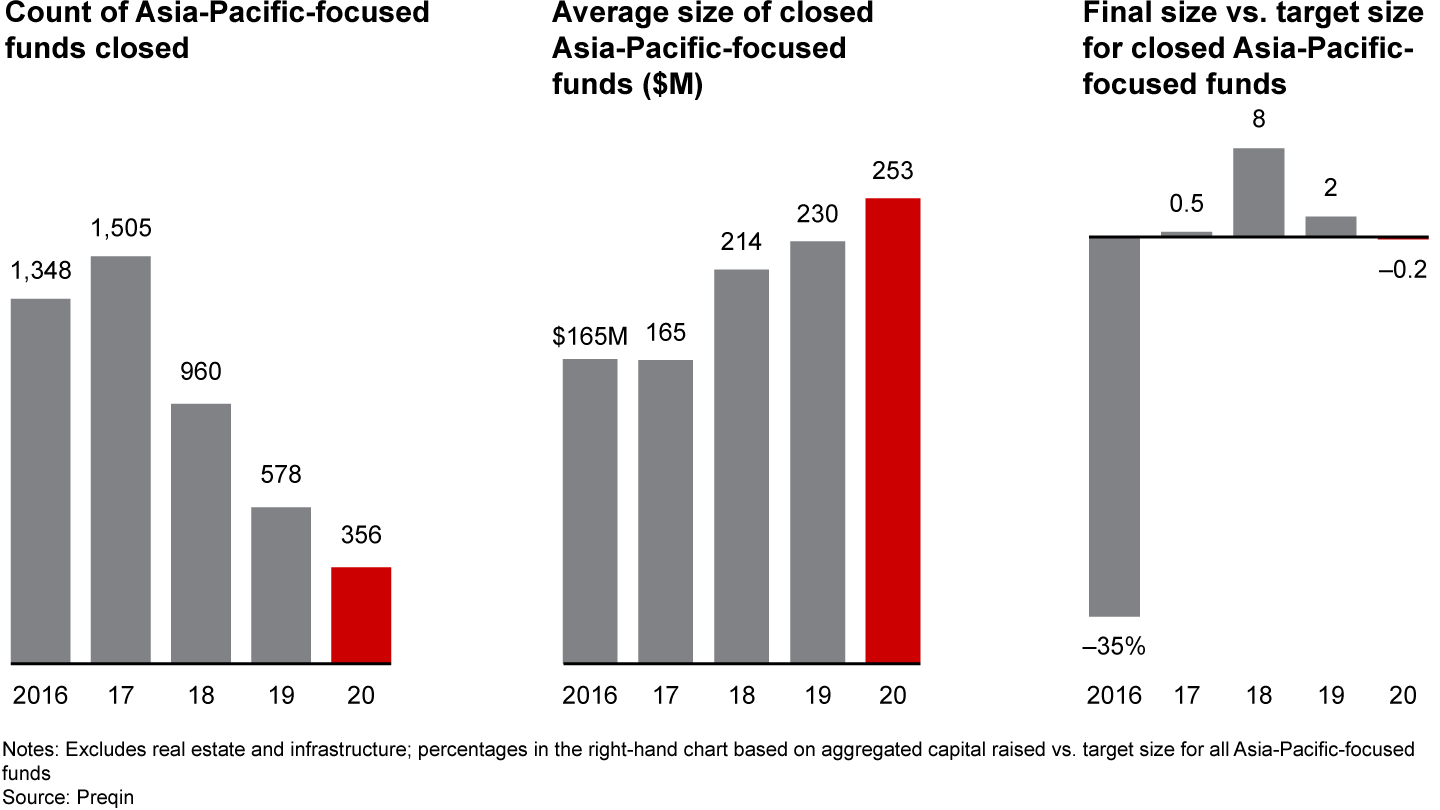
Despite unfavorable market conditions, the time required to close funds in 2020 didn’t increase significantly. For large, experienced funds (over $1 billion), the time to close was the same as the average for the past three years. However, the percentage of funds that met their target dropped significantly to only 60% (see Figure 16). Larger regional funds with strong track records continued to be popular and were able to win strong LP backing. For example, in the second quarter of 2020, MBK closed $6.5 billion MBK Partners V in only six months, exceeding its target size by nearly 10%. It was the largest Asia-Pacific-focused fund raised in 2020.
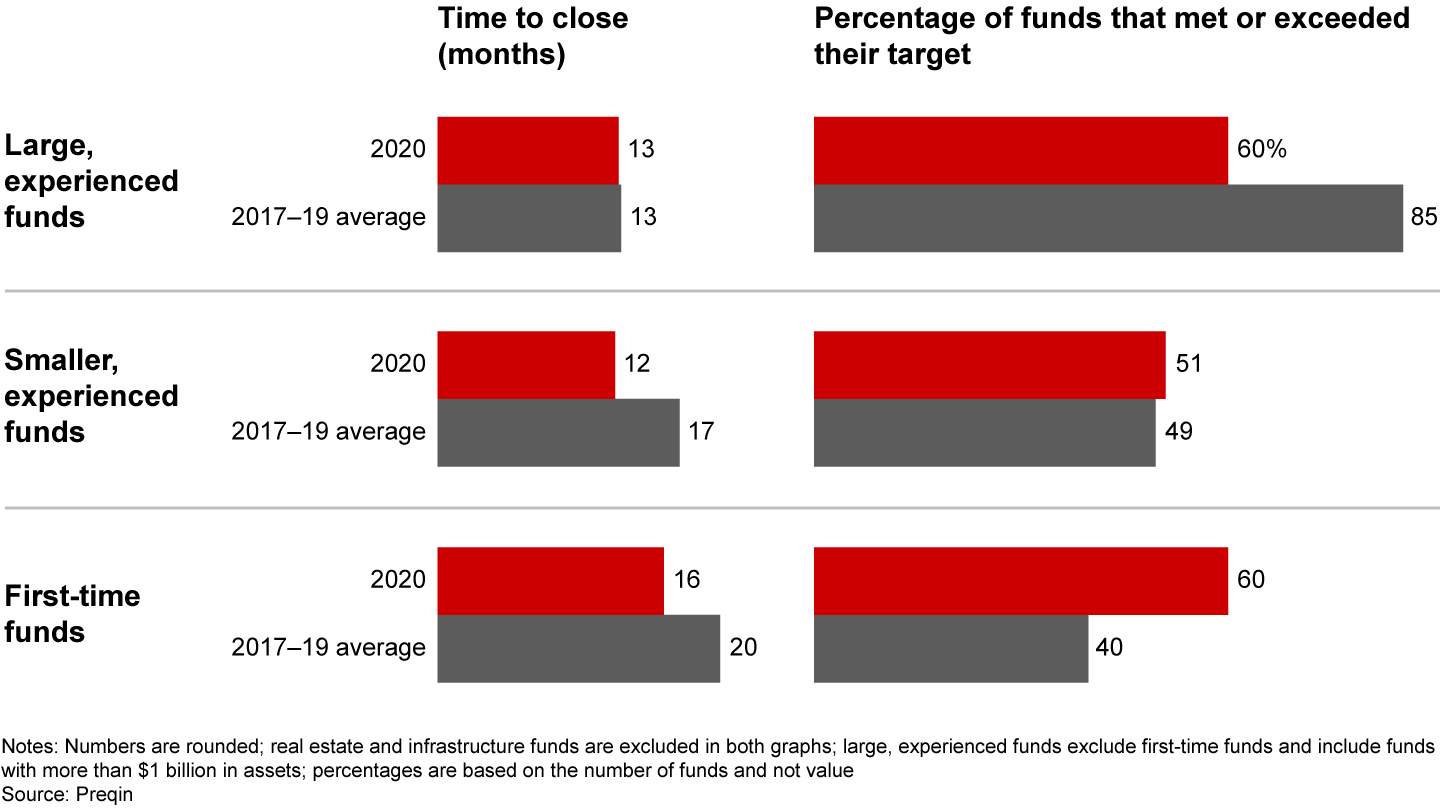
No question, the unfavorable exit environment and uncertainty prompted by Covid-19 affected the overall pace of fund-raising. It was a particularly challenging year for funds with fewer long-term LP relationships and those with a limited track record or none at all. These included smaller experienced funds under $1 billion and first-time funds. Most GPs who successfully launched new funds had a strong performance record and offered investors greater differentiation, such as sector specialization.
Asia-Pacific fund-raising is likely to bounce back in 2021, as efforts delayed last year move ahead. Late in 2020, KKR Asian Fund IV announced a commitment of $13.1 billion—surpassing the largest-ever pan-Asia-Pacific buyout fund—and is expected to achieve a record close in 2021.
The coming years may see a geographic shift in the LP base. More than 30% of GPs in the region expect such a change, according to our survey, including nearly half of China’s GPs. Most expect an increase of commitment from Asian LPs, followed by Middle Eastern LPs, and a decline in North American LPs.
Returns: Another strong year
Despite ongoing disruption and economic uncertainty, private equity returns in the region remained strong. The median net internal rate of return (IRR) was 12.4%, up slightly over 2019’s 12.3%, and significantly outperformed the global benchmark (see Figure 17). Top-quartile funds maintained a high bar: They delivered returns well above most LPs' expectations of 16% for Asian emerging markets.
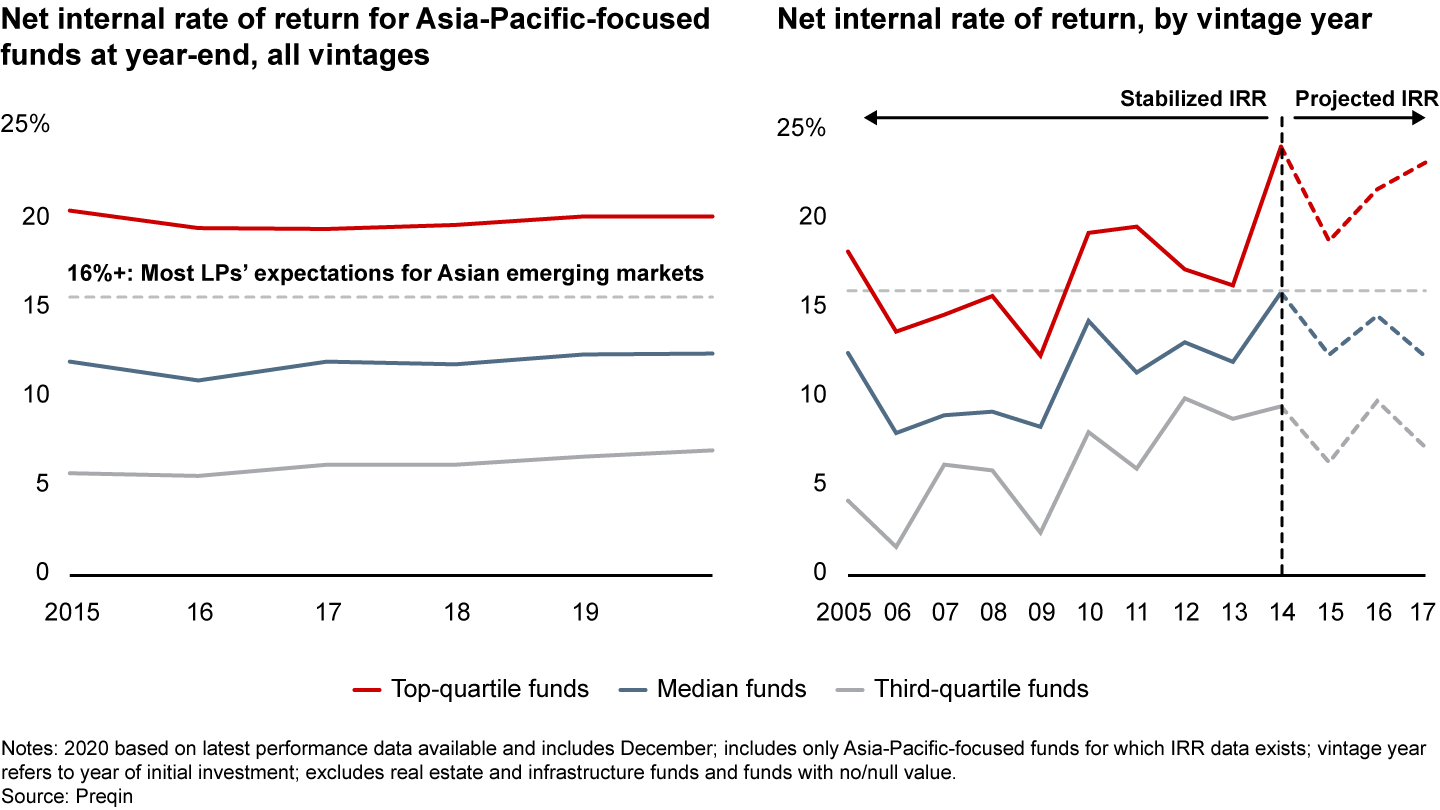
Private equity continued to outperform public markets over 5-year, 10-year, and 20-year horizons, according to Cambridge Associates. GPs are also optimistic that the trend will hold; more than 70% believe returns will remain steady or increase during the next three to five years.
However, LP’s net cash flow in the first three quarters of 2020 remained negative for the third year in a row, a reflection of the tough exit environment (see Figure 18). Negative cash flow to LPs will push PE firms to focus more on value creation. GPs are likely to feel growing pressure to make successful exits through multiple channels and seek alternatives to increase cash distributions in the coming years. In addition, GPs may have a harder time meeting return expectations on earlier-vintage funds as exit pressure mounts and if multiple expansion slows.

Sixty percent of GPs say top-line growth will be the most important factor contributing to returns in the coming five years (see Figure 19). Underscoring that conviction, 56% say they have a robust value-creation plan in place within the first six months of investment, including a short list of key initiatives for most of their portfolio companies. However, follow-through is the sticking point. Fewer than 30% say the majority of their management teams execute their value-creation plans successfully and deliver the intended results.
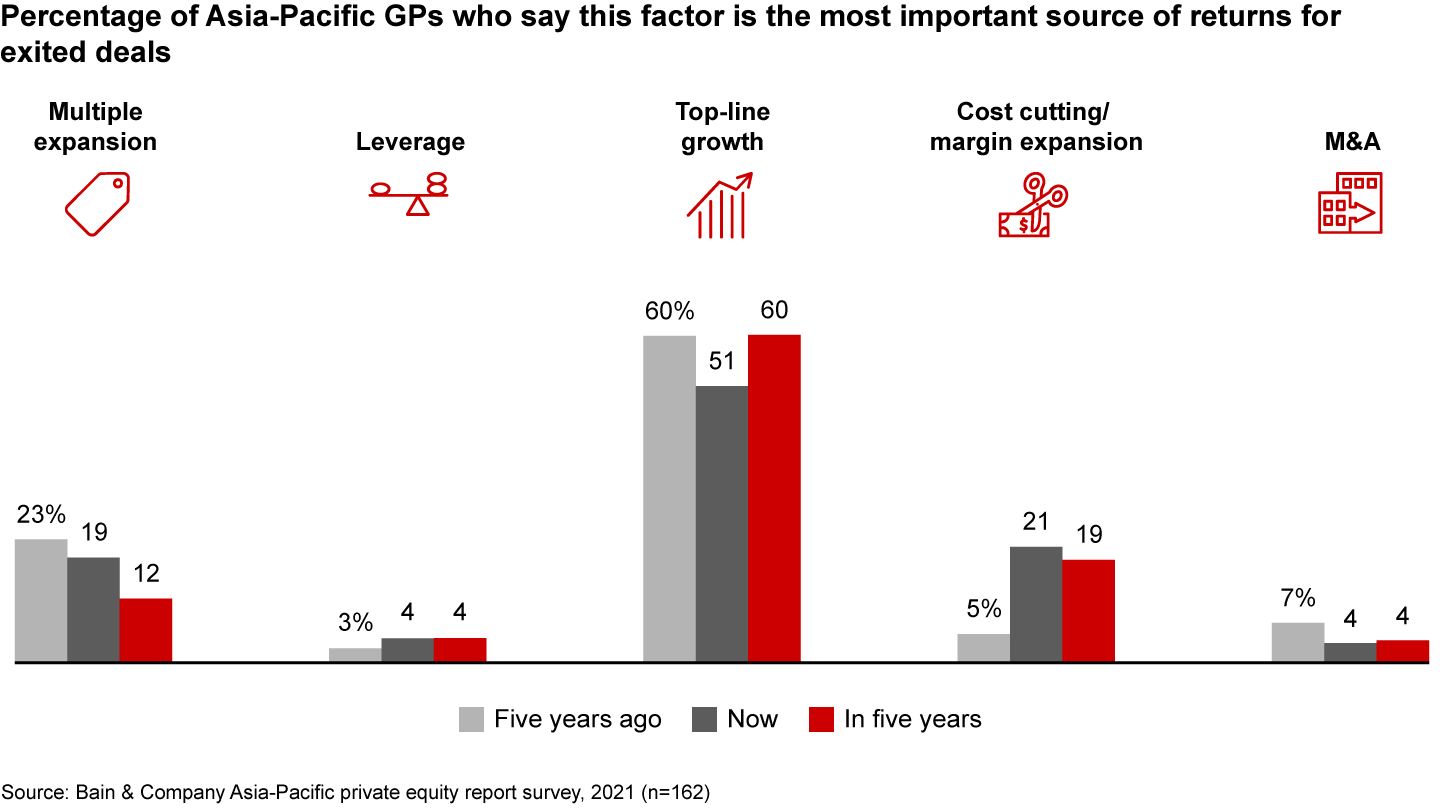
Nearly 20% of GPs say margin expansion or cost cutting would be the key factor in generating returns in the next five years, while 12% are counting on multiple expansion, down from 23% five years ago.
Changing tack in a tougher landscape
Asia-Pacific private equity investors made the best of a difficult year. Amid economic disruption and ongoing uncertainty, audacious GPs jumped back into the market and proved there were plenty of smart deals to do in the right sectors. In particular, they sought out the digital business models and platforms that were undergoing strong growth in the wake of Covid-19 lockdowns. E-commerce and e-learning are two important digital sectors that accelerated in 2020 and are likely to enjoy long-term momentum as consumers adopt new patterns of behavior. We take a closer look at investing successfully in these sectors in the next chapter.
Though the macroeconomic landscape has brightened in 2021, challenges and uncertainties loom ahead. Trade frictions, geopolitical tensions, financial market instability, and climate change are just a few of the forces that could endanger fragile recoveries and trigger a new wave of global turbulence in 2021 and beyond. Stakeholder pressure is also mounting to incorporate rigorous environmental, social and governance (ESG) investment criteria, forcing GPs to rethink their strategies and portfolios.
Above all, the Covid-19 disruptions and economic crisis of 2020 sounded a wake-up call for investors. Many GPs discovered in the midst of the pandemic that their portfolios weren’t sufficiently resilient. As decades of relative global stability give way to a new, more turbulent era, leading funds are reviewing their exposure to a range of risks and investing to increase the resilience of their portfolio companies.
Looking forward—key trends in 2021 and beyond
Digital business models accelerate
Amid the many disruptions and challenges industries faced in 2020, growth powered ahead almost unperturbed in one sector: digital businesses. Private equity investment in Asia-Pacific’s Internet and technology sector already was booming before Covid-19 hit, with the fastest growth in deal value among all industries for five years in a row. But economic lockdowns prompted by the pandemic gave an unprecedented boost to many digital businesses and platforms, heightening investor interest. As governments directed millions of people to work from home or stay at home, consumers began purchasing almost everything online, triggering a surge in online sales. And the extended lockdowns have set the stage for some profound long-term changes in consumer behavior.
The sectors experiencing digital acceleration offer PE investors strong growth opportunities. They include e-commerce, e-learning, digital healthcare, online booking services, online entertainment, and digital payments and financial services (see Figure 20). A comparison of Covid-19-related changes to consumer behavior underscores the potential for these digital business models to outperform. For example, the pandemic triggered an immediate spike in demand for many digital businesses and is likely to boost their long-term growth momentum (see Figure 21).
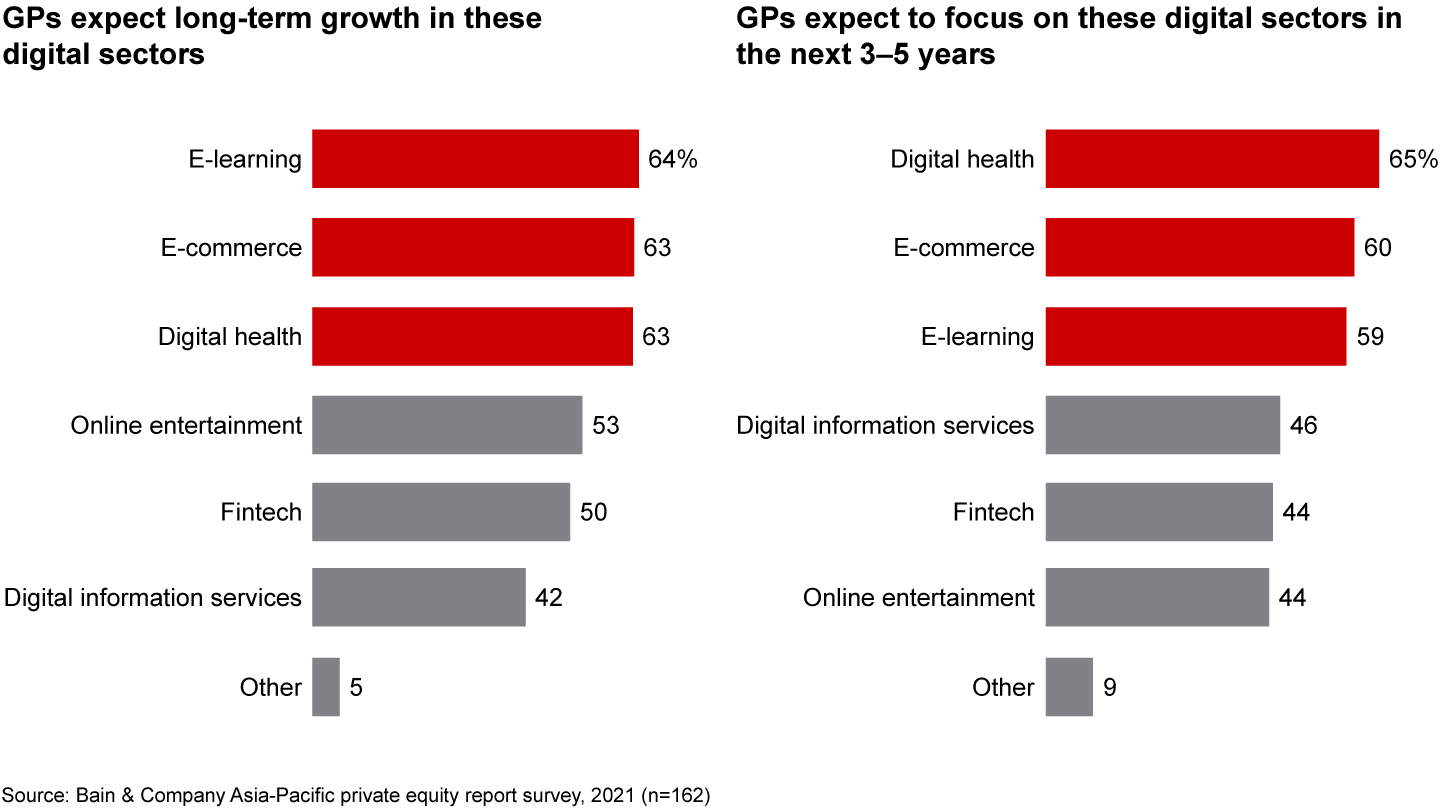
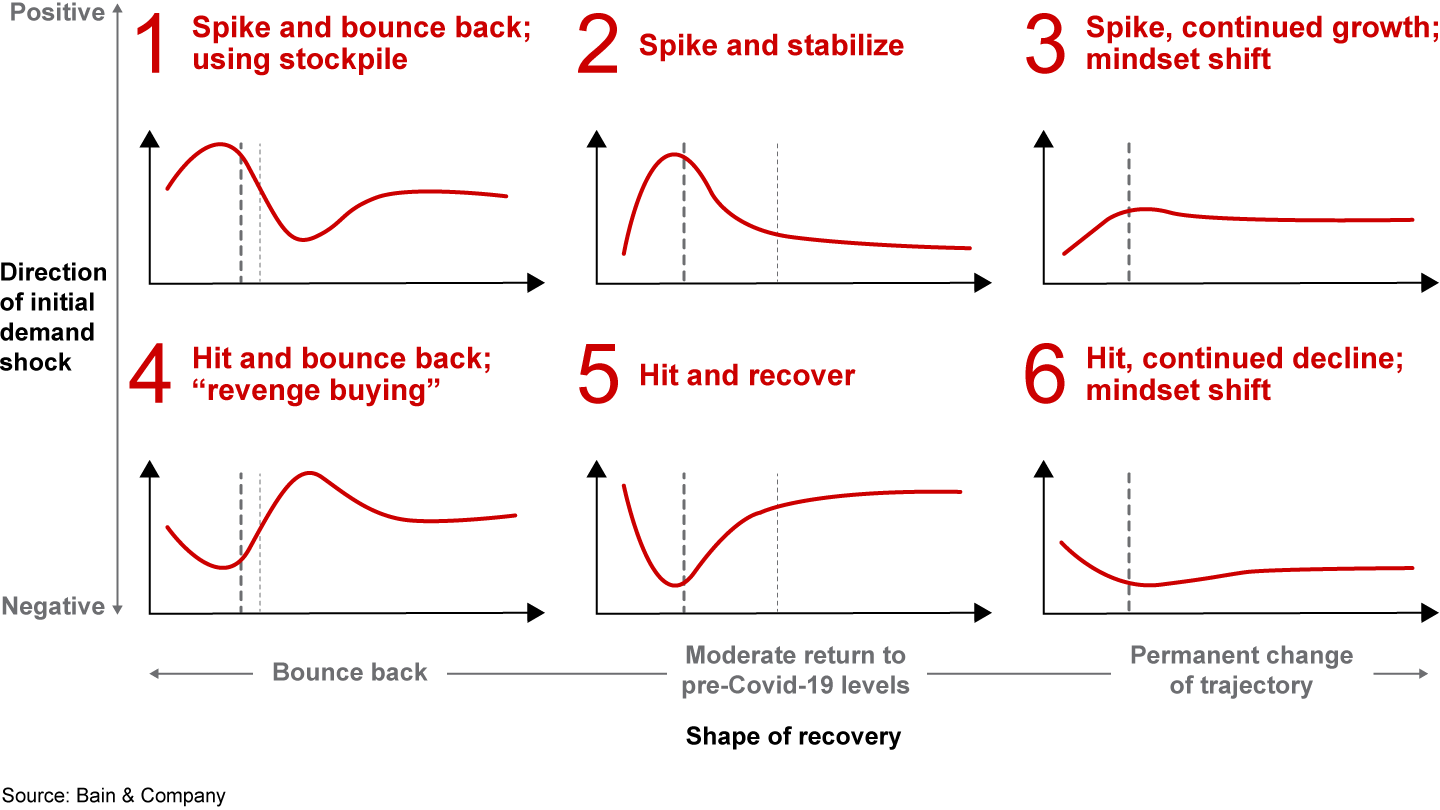
That trend has galvanized fund managers’ attention. Our survey shows 86% of GPs already have increased their focus on these sectors, and 92% plan do so in the next three to five years.
Creating long-term value
For private equity investors, the most important challenge is learning how to analyze businesses in these new and evolving segments. More than 70% of GPs say it’s difficult to evaluate digital businesses and platforms undergoing a sudden acceleration in demand. Lofty prices make the task critical. How can GPs identify companies that will justify high prices by delivering long-term value?
In our experience, several characteristics help PE funds identify the most promising targets in digitally accelerated sectors. They include rapid growth of new users; attractive customer value combined with low acquisition cost; and the potential to distribute additional third-party products over the same platform. Successful GPs also consider potential changes to the regulatory environment that could affect a company’s business, since policy tends to lag the launch of new products and services.
We’ll explore these key elements of successful investing below, but first let’s take a closer look at the opportunity in digital products and services, particularly in two of the most promising sectors: e-commerce and e-learning.
E-commerce growth continues to outstrip expectations
E-commerce was flourishing throughout the Asia-Pacific region prior to Covid-19. China was the most vibrant market in 2019, with a penetration rate of 23% of total retail sales, having grown since 2015 at an average annual rate of nearly three percentage points. India, at the other end of the spectrum, had a penetration rate of only 3.4% in 2019, and has grown since 2015 at an average annual rate of 0.5 percentage points.
Specific market factors fueled different levels of e-commerce throughout the region. In China, new channels such as short video platforms including ByteDance and social commerce groups in WeChat contributed to strong e-commerce growth. The expansion of online businesses in India has been limited by a much lower proportion of Internet and mobile users in the total population. India trails China by seven years when measuring Internet users as a percentage of total population. However, several factors are accelerating India’s e-commerce growth rate, including cheap ubiquitous data, an increase in digital natives’ online spending, and technology innovations.
Across the Asia-Pacific region, e-commerce penetration skyrocketed as Covid-19 lockdowns boosted the number of new customers and increased activity among existing buyers. In China, online consumption-related gross merchandise value in 2020 is on track to reach RMB 20 trillion, shattering Bain’s earlier estimates. The increase in e-commerce penetration in South Korea and Australia in 2020, for example, was at least 2 ½ times higher than the previous five-year average in those countries (see Figure 22).
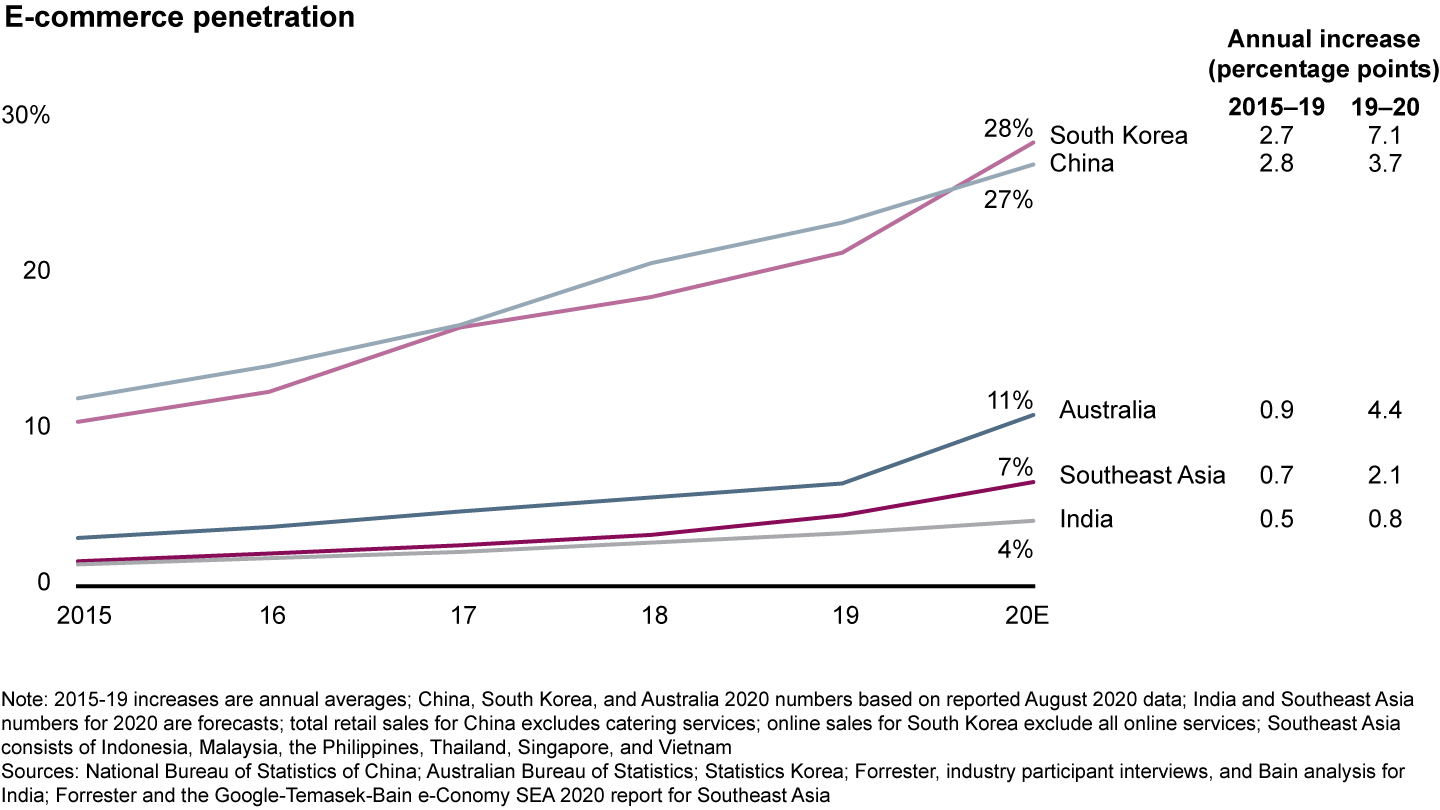
In India, e-commerce penetration grew slower in 2020 than in other Asia-Pacific countries after the government imposed restrictions in April. Even online sales of groceries remained quite low. However, 30% of online shoppers increased spending in categories where they previously made purchases, 16% made purchases in new categories, and 11% of consumers tried online shopping for the first time, according to Bain’s 2020 report How India Shops Online.
It’s too early to forecast how new ways of working and consumer behaviors will influence long-term purchasing trends. But there’s early evidence that the pandemic-inspired rise in e-commerce may fuel long-term growth as a new cohort of consumers comes to appreciate the convenience and choice of online shopping. In Australia and South Korea, the level of e-commerce activity in between waves of Covid-19 lockdowns remained higher than before the pandemic—evidence that some consumers who embraced online shopping because of the lockdown continued to make purchases online after restrictions were eased.
In Southeast Asia, new shoppers generated more than one-third of 2020’s e-commerce activity, and 80% of these e-commerce initiates say they intend to continue buying online in the future, according to the Google-Temasek-Bain e-Conomy SEA 2020 report. While consumers’ desire to avoid exposure to Covid-19 clearly increased online shopping, almost half of Southeast Asia-based consumers surveyed say that saving time and energy is their top reason for shopping online. India echoes the trend: 40% of online shoppers intend to continue shopping online even after the pandemic subsides, according to Bain’s August 2020 Global Pulse Consumer Survey.
Online grocery retailing takes off
Online grocery platforms, one of the final frontiers for e-commerce, have rapidly become a highly attractive PE investment opportunity in the region. Freshness is the No. 1 purchasing criterion for groceries in many Asian countries, and prior to the pandemic, the vast majority of Asia-Pacific consumers preferred to shop for groceries in stores. But as Covid-19 threatened public health, government restrictions on people’s movement and the inclination to avoid crowded shops prompted a surge in online grocery sales. In the second quarter of 2020, web traffic to online grocers soared, particularly in Japan, Indonesia, and Singapore, where average daily visits increased by 25% to 35% over the first-quarter averages (see Figure 23). Importantly, when government restrictions eased, web traffic to online grocers remained higher than before the pandemic in some countries.
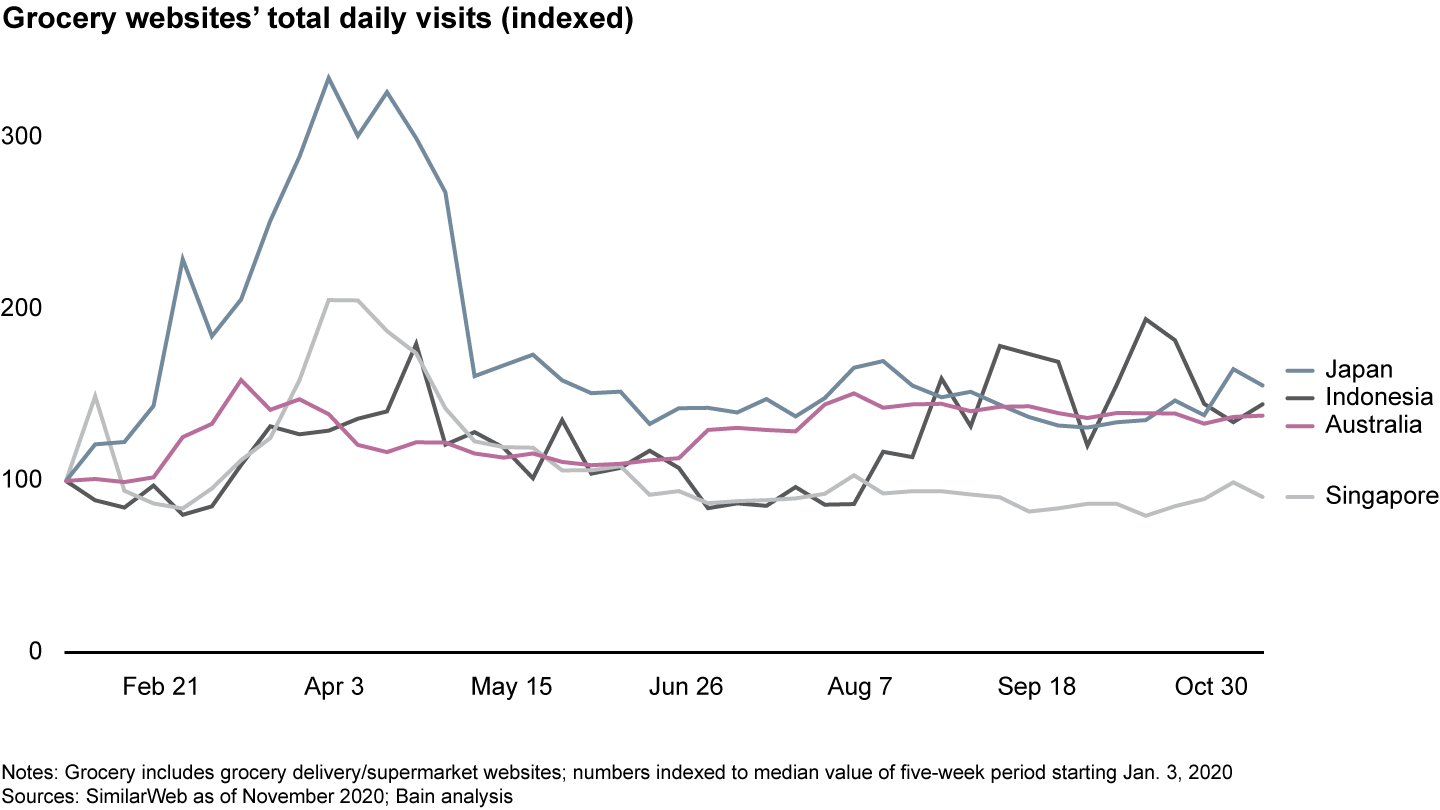
While the upside for winners may be significant, the performance of online grocers varied across the region, and some didn’t expand their user base in 2020—a warning sign for investors. For example, in South Korea and Southeast Asia, some online grocery apps expanded their user base well in excess of 30%, while others faced negative or negligible growth (see Figure 24).
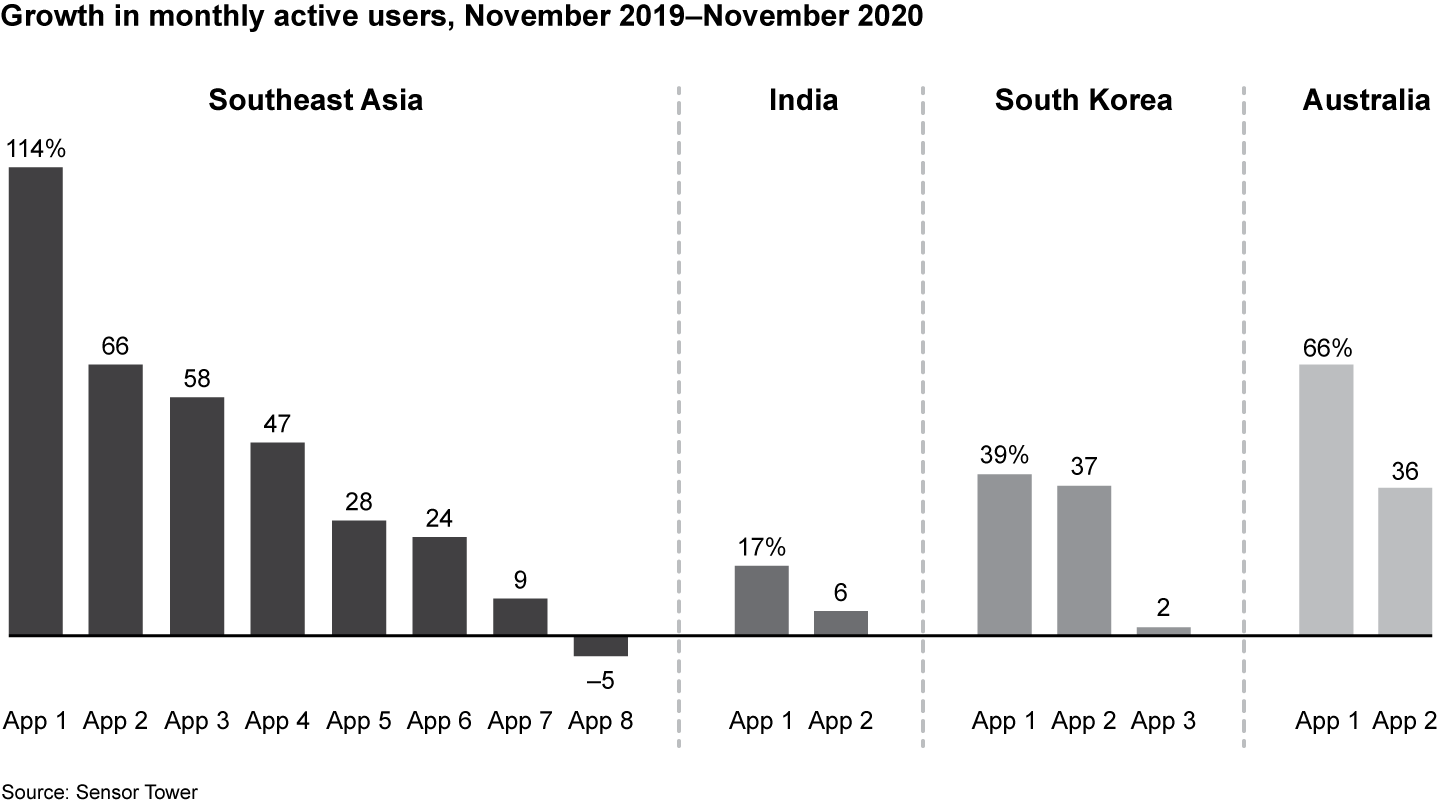
The growth of e-grocery platforms is also propelling changes in the sector’s value chain, including new business-to-business (B2B) platforms that could disrupt the industry. Chinese start-up Meicai, for example, is a fast-growing B2B platform offering restaurants an efficient, one-stop online shop for fresh foods, nonperishable groceries, and restaurant supplies. The platform’s monthly active users (MAU) grew by roughly 80% from November 2019 to November 2020, following a 15% increase in the previous 12 months, as the pandemic increased restaurants’ attention to hygiene, food safety, and quality.
From January 2018 to December 2020, Meicai attracted $1 billion in private equity funds from Hillhouse Capital, Tiger Global, CMC Capital Partners, and Genesis Capital. Historically, China’s online grocers have suffered from inefficiencies linked to fragmented supplier and user bases. Meicai’s platform connects restaurants directly with farmers and other primary suppliers, allowing them to bypass intermediaries and purchase vegetables, meat, and seafood at attractive prices. Meicai is also deploying advanced analytics to enhance category management and predictive accuracy in operations.
A vast new market for e-learning
By mid-April 2020, Covid-19 had forced schools and universities in 180 countries to close, affecting 85% of the world’s elementary and secondary student population, or nearly 1.5 billion students, according to the World Bank. The pandemic also shuttered 99% of higher education institutions, eliminating classroom instruction for 220 million college students worldwide. To bridge that gap, educators turned quickly to e-learning solutions and online education platforms, giving the sector a powerful boost.
E-learning had been on a strong growth trajectory in Asia-Pacific countries before the pandemic hit, but the adoption of digital education services rose sharply throughout the region during the first half of 2020. Since then, growth has either continued or stabilized, increasing the sector’s attractiveness.
From 2016 to 2020, GPs closed more than 160 e-learning deals, primarily focused on the digital disruption of traditional education in Asia-Pacific countries—and 30% took place in 2020. Those investments involved several key players: Yuanfudao ($3.5 billion in total deal value last year), TAL Education Group ($3.3 billion), and Zuoyebang ($2.4 billion) in China, and Byju’s ($1.2 billion) in India. And e-learning deal value in 2020 reached an all-time high of $13 billion (see Figure 25).
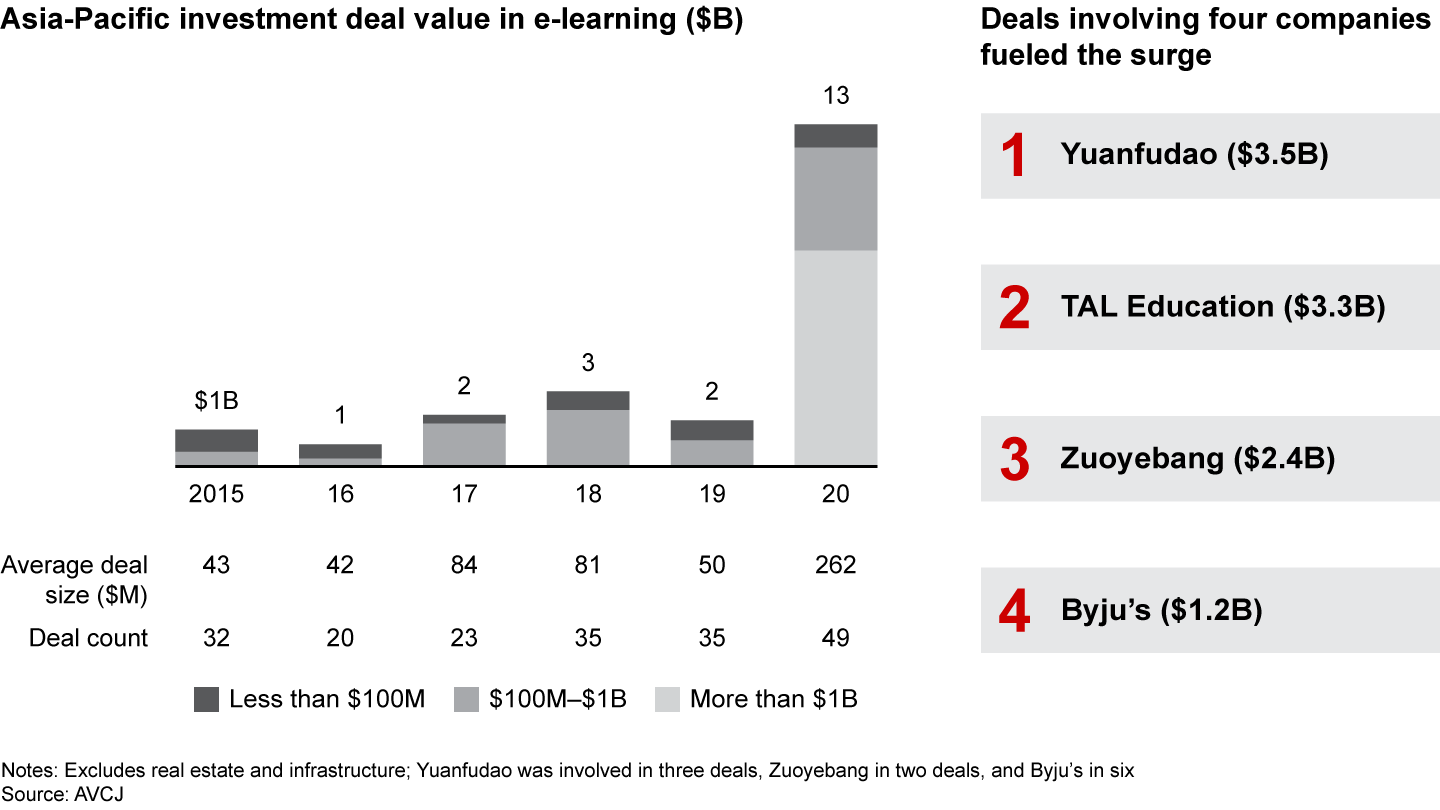
The number of monthly active users at China’s top four e-learning applications for grades 1–9 increased by an average 73% from January to February in 2020. That rise compared with a 4% decline in the same period a year earlier (see Figure 26). During the course of the year, many students in China and the Asia-Pacific region started returning to their classrooms. Nevertheless, in October 2020, the MAU for the same four applications was up almost 40% year-on-year, affirming the long-term attractiveness of e-learning. In contrast, in October 2019, the average MAU for the same four apps declined by 4% from the previous year.
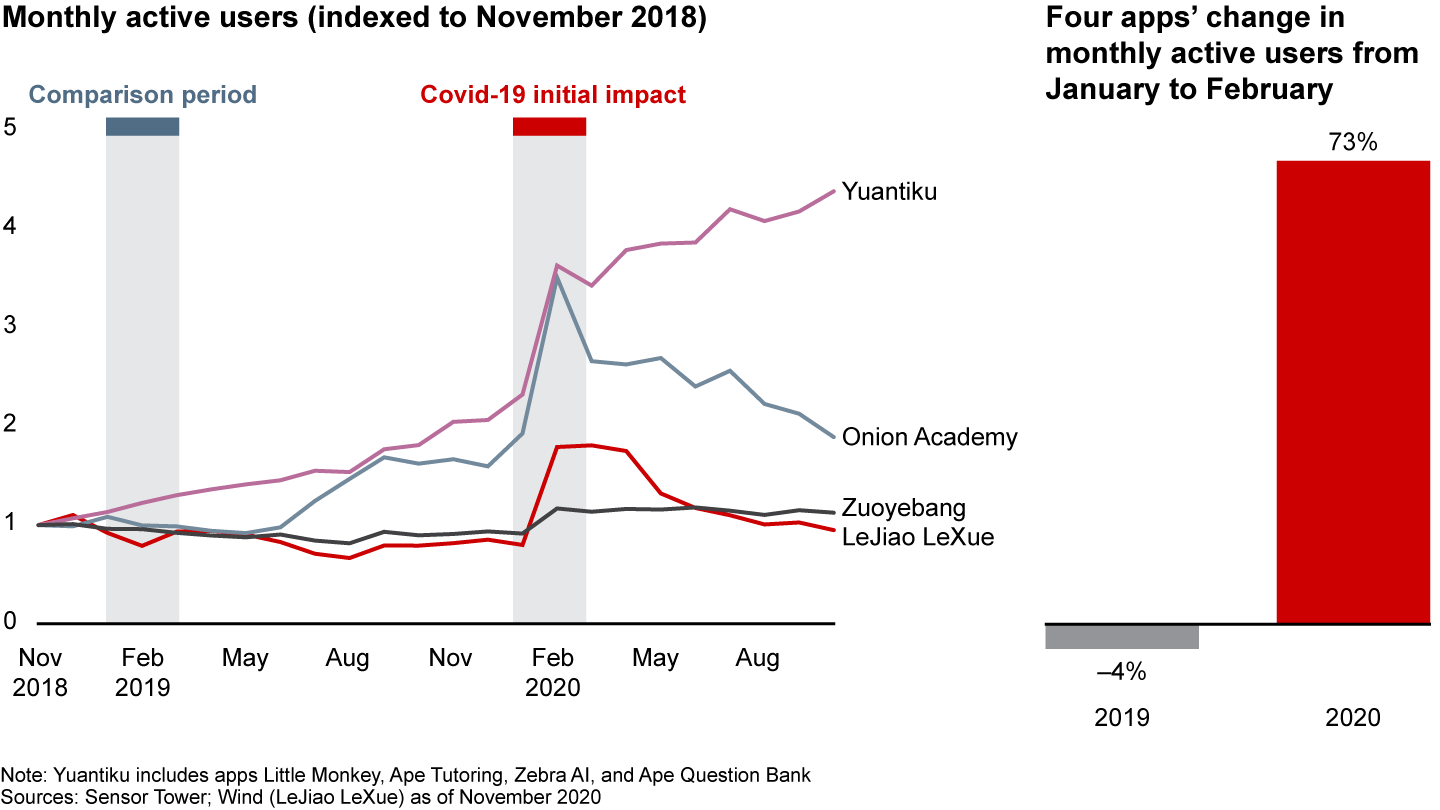
The spectacular rise of India’s e-learning platform Unacademy highlights the sector’s powerful growth potential. Founded in 2015, Unacademy has quickly become one of India’s largest digital disruptors in education, with a MAU base in November 2020 of almost 21 million students. Last year, it joined the region’s fast-growing unicorns, start-ups with a valuation of $1 billion or more, following a private equity investment in November by Tiger Global and Dragoneer Investment that valued the company at $2 billion. Eight months earlier, a $110 million investment by General Atlantic, Sequoia Capital, and others had valued the company at $400 million.
Founder Gaurav Munjal launched Unacademy as a YouTube channel in 2010 and created a business platform five years later. The Bangalore-based company, with its mission to make high-quality education affordable and accessible to everyone, has built a network of more than 47,000 educators that provides multilingual materials and classes to help students prepare for educational and professional entrance exams.
Demand for Unacademy’s services were strong prior to Covid-19. When it was launched, Unacademy filled a critical gap: The traditional market for test preparation and coaching suffered from inconsistent quality and limited access outside of major cities. But the pandemic put Unacademy’s growth into overdrive. The platform’s MAU in November 2020 was up 148% year-on-year, more than double the previous year’s average growth of 71% (see Figure 27).
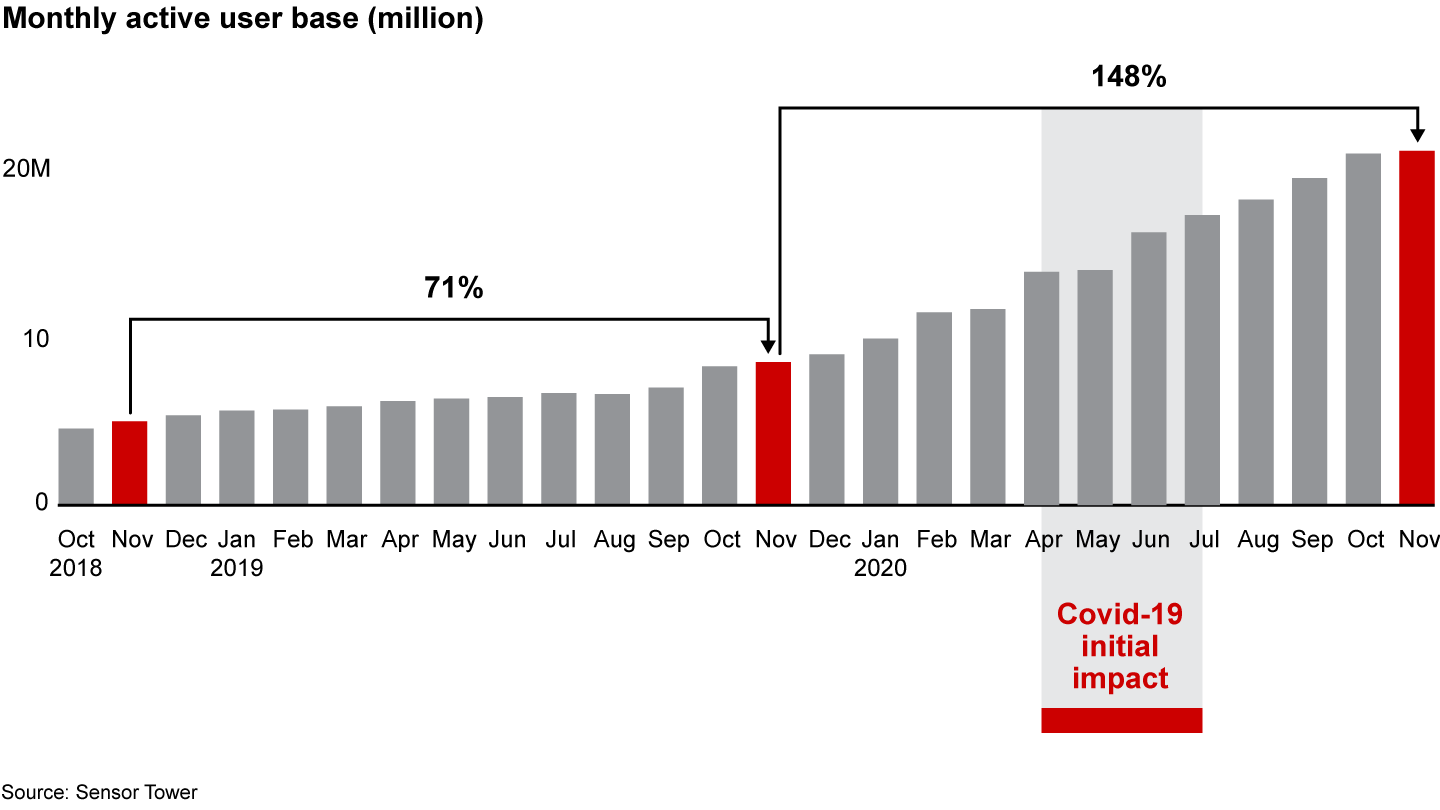
India’s market for e-learning is likely to be attractive beyond the Covid-19 recovery. The country’s low digital penetration rate leaves plenty of room for expanding the consumer base. Leaders such as Unacademy, Byju’s, and others point to the successful path to scale in e-learning. Winners provide a smooth user experience and high-quality teaching, while ensuring the business is profitable on a per-customer basis.
Implications for investors
Digitally accelerated businesses like e-commerce and e-learning are challenging to evaluate. In our experience, successful funds use deep sector and geographical expertise to identify the most promising targets. They also analyze company-specific dynamics likely to affect value creation. Finally, they focus more sharply than ever on four key factors during due diligence to ensure viable long-term growth.
The addressable market. When a sector is undergoing explosive growth, it’s difficult to estimate how big the addressable market may become. Two key steps can help investors make a reasonable assessment. First, analyze the specific business definition of the company, including its core customers, the market needs it addresses, and key competitors. Second, assess where the market is along the adoption curve (S-curve).
For example, e-learning players that focus on extracurricular classes are creating completely new markets, tapping into the unmet demands of parents. Benchmarking the adoption trajectory of an extracurricular course in the same country or similar platforms in other countries (accounting for structural differences) provides one possible top-down proxy.
Often, estimating market potential requires management teams to assess unmet consumer demand in the target sector. With online education platforms in China, for example, the first step is determining the percentage of consumers who might be interested in those services. The next step is looking at potential adoption curves by various city tiers, based on key factors such as disposable income and alternative options. This type of consumer segmentation allows investors to build a bottom-up view of the market for e-learning and specific subsectors of the business.
Differentiated value proposition. While more than one platform may be able to prosper in a niche e-learning sector, successful companies differentiate their offers. That approach helps limit competition and ensure long-term sustainability.
Differentiation in e-learning could focus on the curriculum, one or more star teachers, easily identifiable results, or innovative online techniques. For example, an online coding class might offer customized, real-time interactions between teachers and students. The coded programs can easily be shown to the parents, which motivate students with a sense of accomplishment.
Sustainable unit economics. Successful funds weigh the high acquisition cost of digital businesses against the lifetime customer value to ensure that the long-term unit economics of the business are attractive. Lifetime customer value includes all the cash generated by a given user from the time of acquisition to the time he or she stops using the platform. Ideally, lifetime customer value should exceed the acquisition cost by several multiples.
The ratio of lifetime customer value to new customer acquisition cost depends on several variables, including promotion costs to acquire customers, the cost to serve existing customers, the churn rate, and additional cross-selling opportunities. For example, in Unacademy’s live-teaching model, the cost to serve customers is significantly higher than for competitors that use prerecorded content. However, it’s a calculated trade-off. Higher-quality teaching results in a lower student churn rate, and over time, better unit economics.
In both China and India, for example, new customer acquisition in sectors like e-grocery or e-learning are becoming increasingly expensive. GPs should use due diligence to gain a solid understanding of the target’s ability to acquire and retain customers. For online grocery businesses, factors such as fulfilment costs, waste, and average basket size all fundamentally affect unit economics.
Regulatory risks. Think the unthinkable. Regulation is a major source of both risk and opportunity for all digital businesses. Top-performing funds ensure they understand a target’s regulatory landscape and aren’t surprised by laws or regulations that suddenly alter the market dynamics. Policy changes that restrict e-learning content or alter its affordability, for example, can propel growth for some companies and eliminate value for others. Governments may decide computer coding should be part of the elementary school curriculum—or not. A positive decision could boost online education services in coding, while a negative one would limit demand.
While Covid-19 has altered the dynamics of many industries, powering the growth of digital businesses such as e-commerce and e-learning, digitally accelerated sectors are a bright spot amid ongoing economic uncertainty. The broader investment backdrop is changing fundamentally as global risks multiple. Leading GPs are making sure their portfolio companies are braced for the challenges ahead and are investing to build resilience.
Building resilience
The number and magnitude of external shocks is rising in most industries. Trade wars, plunging oil prices, and financial crises have hit many companies harder than executives imagined possible. Then came Covid-19. The pandemic triggered wide-scale disruption to global supply chains, and economic lockdowns threatened the survival of some companies. In our annual Asia-Pacific private equity survey, conducted in December, GPs ranked the effects of Covid-19 among their top three concerns about market conditions (see Figure 28).

Even after the pandemic ebbs, however, turbulence is likely to continue as globalization unwinds, inequality rises, and climate change triggers a growing number of catastrophic events. Adding to the dilemma, a decades-long fixation on efficiency has steadily increased risk. No wonder leading GPs are sharply focused on increasing portfolio resilience. In our annual survey, more than 60% of GPs say they’re willing to invest at least 5% of a portfolio company’s short-term profit to build long-term resilience (see Figure 29).
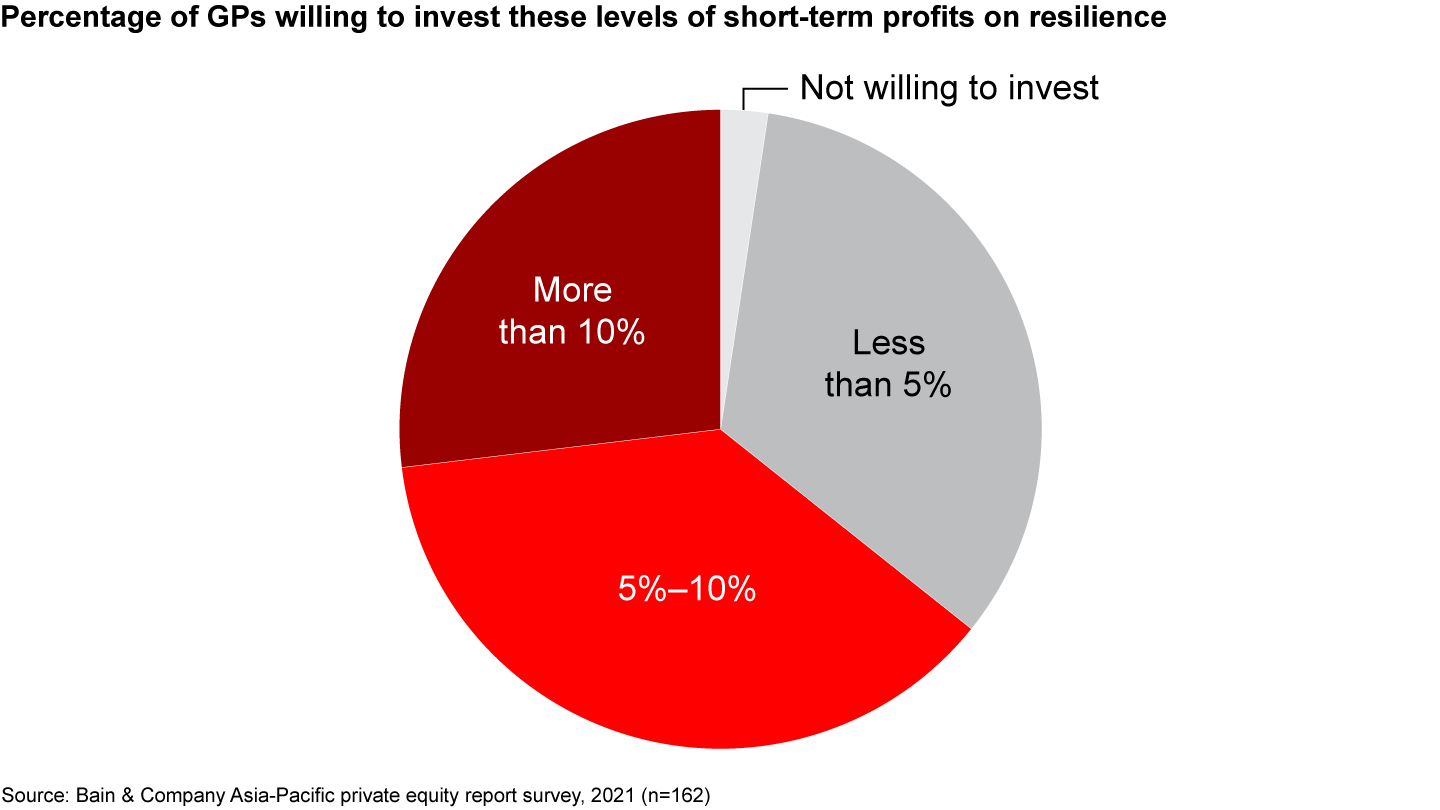
The Covid-19 challenge
Companies around the world, including those in the Asia-Pacific region, are still feeling the pain from economic lockdowns prompted by Covid-19. More than 80% of Asia-Pacific GPs say the pandemic increased operational disruptions, and 75% say they’re experiencing greater financial pressure. More than half of these GPs also indicate that their portfolio companies face increased strategic pressure, technological disruptions, and organizational pressure (see Figure 30).
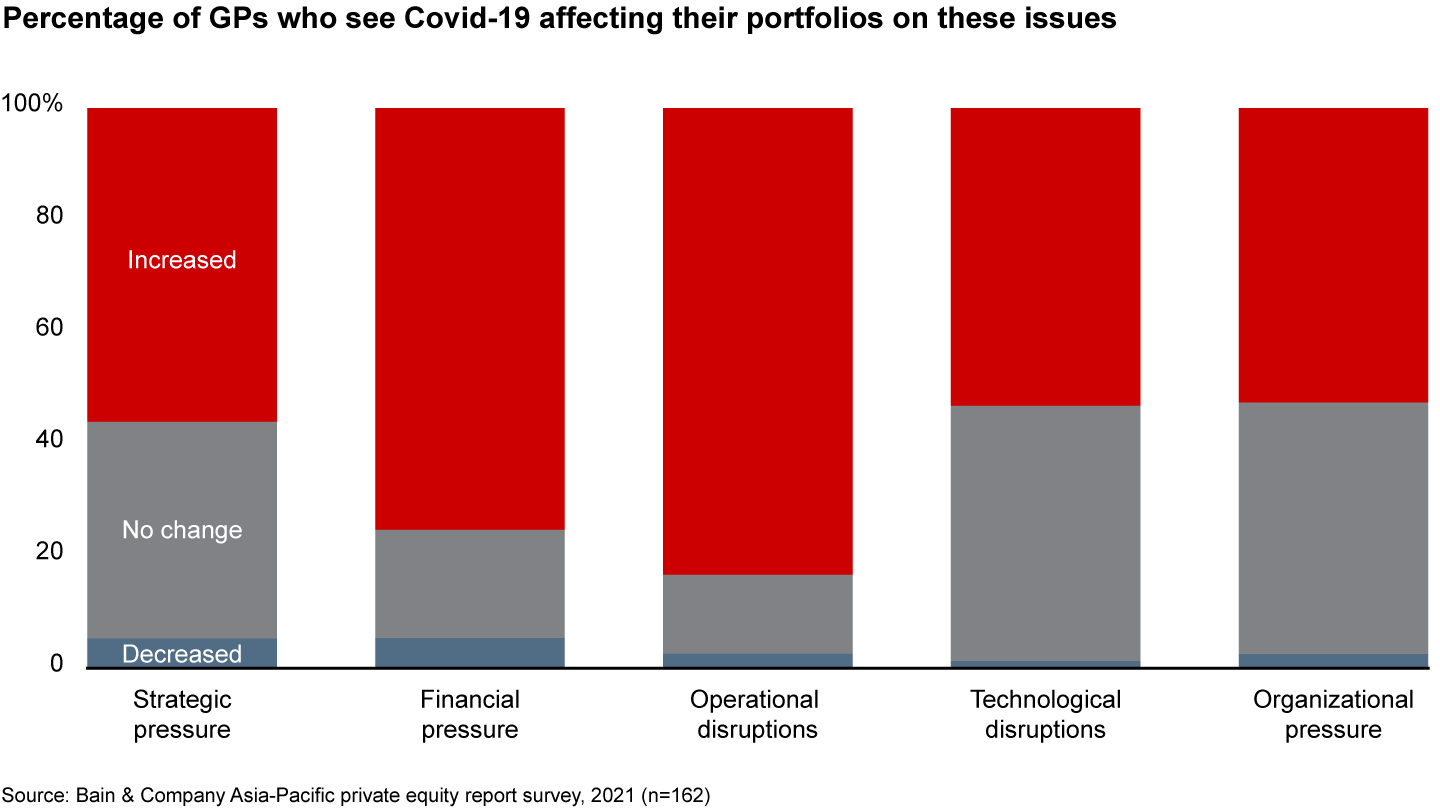
Most companies were caught off guard by Covid-19. The majority of GPs we surveyed (58%) say their portfolios proved to be only somewhat resilient or not really resilient during the Covid-19 shock (see Figure 31). More than one-third of GPs say they’re still in the early stages of applying specific tools or don’t have any tools to assess the resilience of a target. Close to one-third say their portfolio companies are still in the experimental or even earlier stages of building resilience capabilities into their strategy and operations.

Five dimensions of resilience
Resilience is the capability to survive and recover from sudden shocks. By their nature, risks are a moving target, so building resilience requires a long-term effort and focus. Many business leaders make the mistake of assuming that resilience is all about shoring up the balance sheet. They focus on the risks associated with leverage and liquidity, but ignore other potential sources of fragility.
Successful companies take a holistic view of resilience. That means identifying every kind of external event that can affect the business. They also consider simultaneous events across multiple channels that could compound the extent of a shock. A broader, more encompassing view of both risk and resilience allows leadership teams to make smarter choices about where to invest limited resources to protect the company from future shocks.
In fact, resilience spans five dimensions, with some of the most important elements spelled out below.
Strategic. This includes relative market share, demand elasticity, revenue and profit diversification, and cross-correlations of portfolio businesses when exposed to changing market conditions.
Financial. Companies must consider leverage and liquidity, as well as insurance coverage and hedges.
Operational. Operating leverage―the extent to which a company can raise operating income by raising revenue―is another factor, along with supplier concentration, and redundancy.
Technological. Technology needs to be available, reliable, mobile, and secure.
Organizational. This includes personal resilience, as well as the organization’s agility and readiness for crises.
How to measure portfolio resilience
Improving a company’s resilience can almost double its chances of survival and improve cost-effectiveness over time. Executive teams may be able to address some risk factors quickly and inexpensively, but an effective approach to building resilience usually requires investment and opportunity cost. How can GPs and executive teams strike the right balance between managing risk and value creation? Leading companies begin with a fact-based analysis of the nature and extent of their major vulnerabilities. They gather the metrics that highlight a company’s risk exposure, and ask a few key questions.
To that end, we constructed the Bain Resilience Index, a 100-point scale that assesses a company’s resilience based on the statistical relationship between performance during a crisis and a wide range of readily observable metrics including scale, growth, margin, asset intensity, leverage, liquidity, and geographic and product concentration. While these metrics offer only a partial assessment of resilience, understanding your relative position on these basic dimensions offers a useful start for a fact-based dialogue and further diagnosis.
In addition, a few simple questions can help GPs focus on the portfolio’s resilience and priority areas to improve it.
- What’s the nature and extent of risks your company faces? How much stress could it absorb?
- Based on the investment time horizon, how much risk exposure are you willing to carry?
- Which of the five dimensions of resilience are the most critical for your company?
- To what extent are you willing to trade off short-term profitability for long-term resilience?
- What are the no-regret actions that will strengthen resilience with minimal impact on profitability?
Portfolio resilience case studies
Resilience is a strategic issue. Investors and senior managers need to be involved, because decisions to build resilience involve difficult choices. A plan to increase resilience may start off with quick, low-cost actions, but significant gains often require important investments.
Asia-Pacific GPs cite three areas of portfolio risk that they worry about most: competitive position, balance-sheet risk, and organizational agility (see Figure 32). Addressing these risks may require more investment. GPs rate other categories of risk such as portfolio concentration, operational leverage, and cybersecurity as less difficult to tackle.
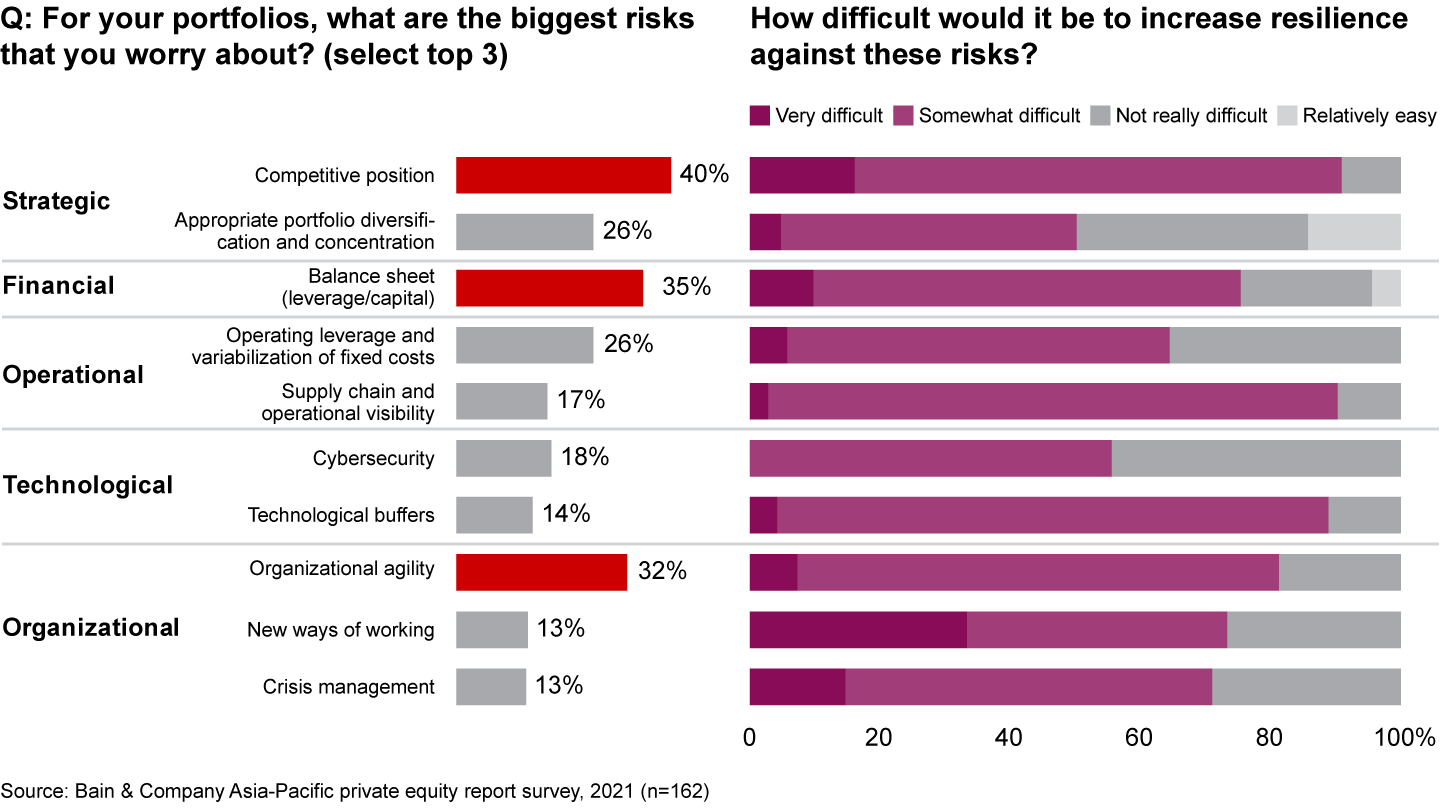
Each portfolio company is likely to require a different approach and different priorities to building resilience. Below we discuss two cases that highlight a range of actions.
PT BFI Finance Indonesia
In 2019, TPG Capital and Northstar, investors in Indonesia’s PT BFI Finance, supported the management’s plan to increase the group’s strategic and organizational resilience. One of Indonesia’s largest independent consumer credit companies, PT BFI Finance aimed to strengthen the organization following two strong years of growth in 2017 and 2018. Management’s actions helped it weather the fallout from Covid-19 better than its peers. Despite widespread economic disruption caused by lockdowns, the group’s nonperforming loans declined during the pandemic.
One particularly effective measure improved loan-collection efficiency prior to Covid-19 by experimenting with a call-center collection agency to supplement field collectors’ efforts. These “telecollectors” helped the finance group reach out early to creditors who risked defaulting and, in some cases, avoid nonperforming loans. During the pandemic lockdowns, the remote-collection strategy offered a safe and vital alternative to in-person collection, allowing the company to minimize defaults. In September 2020, nonperforming loans declined to 2.7% for total financial assets, down from 3.7% in June—and significantly lower than the market average of 5.2%.
HCP Packaging
After Baring Private Equity Asia acquired HCP Packaging Group in 2016 for $775 million from TPG Capital, it helped build a more resilient company by backing a plan to add new production sites and diversify its customer base. Those moves made a big difference when the US–China trade war hit global supply chains and when Covid-19 struck.
HCP, founded in 1960, is a global leader in the design and manufacture of cosmetics and skincare packaging for leading beauty brands. To improve its operational resilience, the group started investing in 2018 to expand its international manufacturing footprint beyond China and North America, with production acquisitions in France and Germany. When the China–US trade war broke out, HCP quickly shifted part of its China production to other countries. Similarly, as Covid-19 lockdowns began, HCP was able to make the most of its expanded manufacturing footprint and supply chain flexibility, outmaneuvering the competition.
The second pillar to the group’s resilience strategy focused on broadening the customer base geographically. Historically, HCP’s major clients were global cosmetics companies in the US and Europe. Under Baring’s ownership, the company broadened its customer mix and expanded in China, selling to insurgent cosmetic brands such as Perfect Diary. That strategy helped the group compensate in 2020 for slower sales in the US and Europe with a surge in revenues from China, where the market for color cosmetics and skin-care products bounced back faster. Despite the pandemic, revenues from HCP Packaging Group’s insurgent brand customers in China doubled in 2020.
Leading fund managers and executive teams seeking to strengthen resilience make sure they tackle the no-regrets actions first—those with minimal impact on profitability. But they also understand that significantly reducing risk entails investment and opportunity cost. Developing the right level and type of resilience for a portfolio company demands a combination of short-term actions and long-term vision and alignment with the executive team.
Conclusion
Asia-Pacific private equity investors grappled with unprecedented uncertainty and disruption in 2020, but they ended the year on a high note. Despite the pandemic and economic downturn, deal value set a new record, and Asia-Pacific PE assets under management rose to 28% of the global total. Greater China’s market bounced back, and India continued its strong growth. Private equity returns again outperformed public market returns.
Difficult market conditions meant fewer exits and a drop in fund-raising, and GPs face greater pressure to trim portfolios and find new investments. But most of the region’s fund managers feel positive about the macroeconomic climate in 2021. Covid-19 lockdowns boosted digital businesses, including e-commerce and e-learning, which are likely to grow faster than other businesses even after the pandemic passes.
As GPs review their strategies for 2021 and beyond, leaders are taking steps to bolster the resilience of their portfolios and minimize the risk of future disruptions. GPs and LPs are focusing on environmental, social and governance investing, and a growing number of PE funds are shifting to sustainable portfolios.
If 2020 made one thing clear, it’s the vibrant underlying dynamic in Asia-Pacific’s private equity sector. Many signs point to ongoing momentum for dealmaking in 2021. Mounting pressure on funds to increase distributions to LPs will prompt GPs to reevaluate their portfolios, and fund-raising is likely to accelerate. While there are plenty of challenges ahead, Asia-Pacific GPs are well-positioned to build on their achievements in the coming year.
Market definition
The Asia-Pacific private equity market as defined for this report
Includes:
• Investments and exits with announced value of more than $10 million
• Investments and exits completed in the Asia-Pacific region: Greater China (China, Taiwan, and Hong Kong), India, Japan, South Korea, Australia, New Zealand, Southeast Asia (Singapore, Indonesia, Malaysia, Thailand, Vietnam, the Philippines, Laos, Cambodia, Brunei, and Myanmar) and other countries in the region
• Investments that have closed and those at the agreement-in-principle or definitive agreement stage
Excludes:
• Franchise funding, seed and R&D deals
• Any non-PE, non-VC deals (e.g., M&A, consolidations)
• Real estate and infrastructure (e.g., airport, railroad, highway and street construction; heavy construction; ports and containers; and other transport infrastructure)































